Those of you who have played the game of World of Warcraft know it's not all about purple pixels, doing the phattest damage and hanging out with the coolest people on the server.
It's also about gold. Filthy lucre, used to pay for the consumable items, enchanting and crafting materials, and mounts used to provide the phattest damage and get you to the raid instance as quickly as possible.
This series is intended to cover what you do in between raids, broken down by phase. Starting with the combined first and second phases.
Now please note here, that this is intended to be an anecdotal first hand account of what I did and what I observed. Other players' experiences might have been totally different. So don't blame me if Burning Crusade Classic 2: the Return of Jafar comes out and you have a totally different experience to mine.
Moneymaker No. 1 - Farming
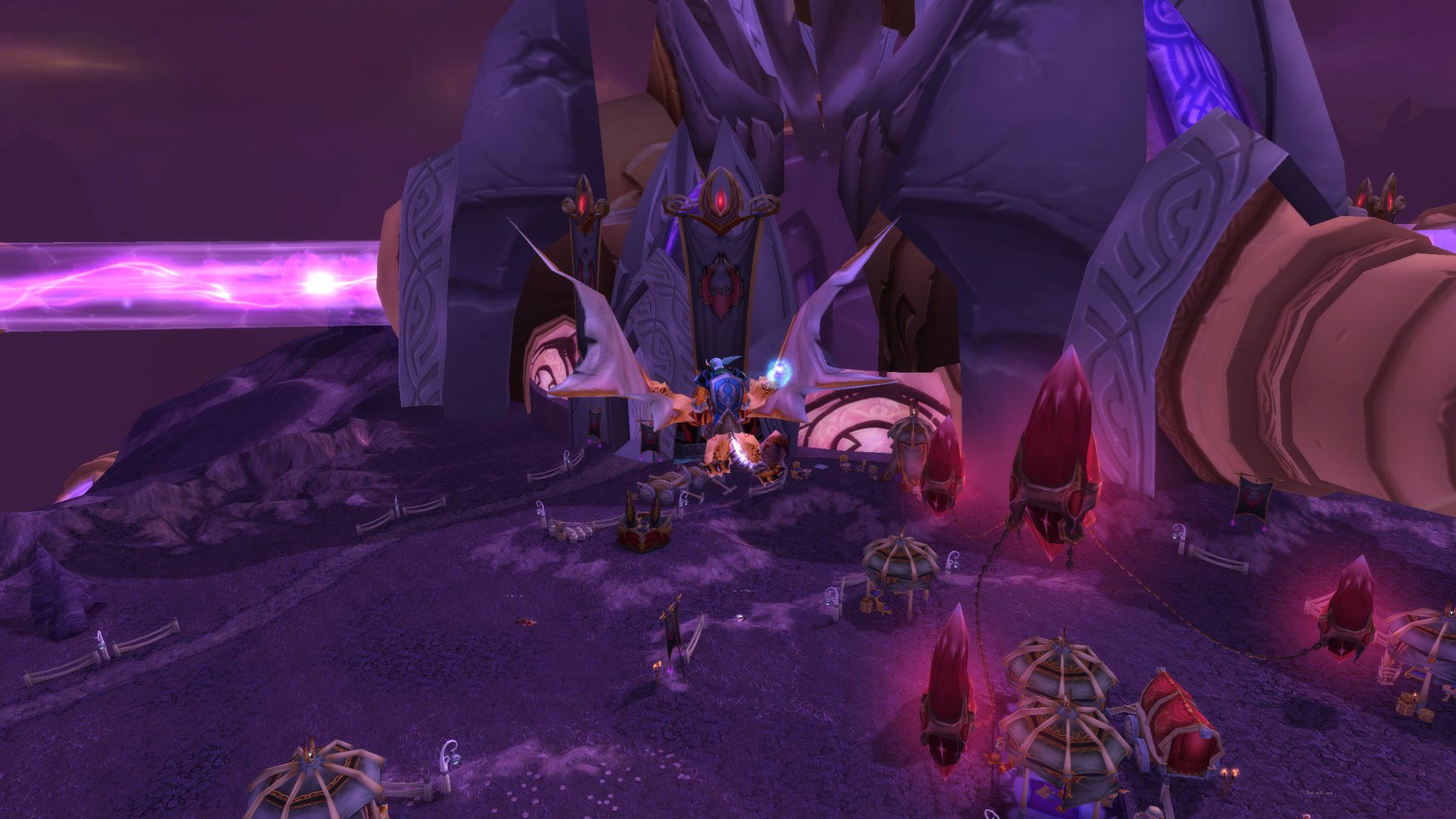
Farming never goes out of fashion - as sure as shootin', someone is willing to pay the price of convenience. It's one of the building blocks of every expansion. You can turn your time into cold hard make-believe cash in a flash, provided you know what to farm and who might need it.
As with the start of any cycle, the prices for everything were ridiculous. Prices for Primals, required for crafted epic equipment and higher-end item enchantments, were upwards of 20 - 25 gold. For reference, in Phase 5, they ended between 5 - 15 gold, depending on the primal you want.
If you wanted Primal Fires, useful for spell damage enchants, and the Phase 2 super-item, the Belt of Blasting, you farmed them up by the Throne of Elements in Nagrand, or the Throne of Kil'Jaden. Apparently fire elementals like thrones, who knew.
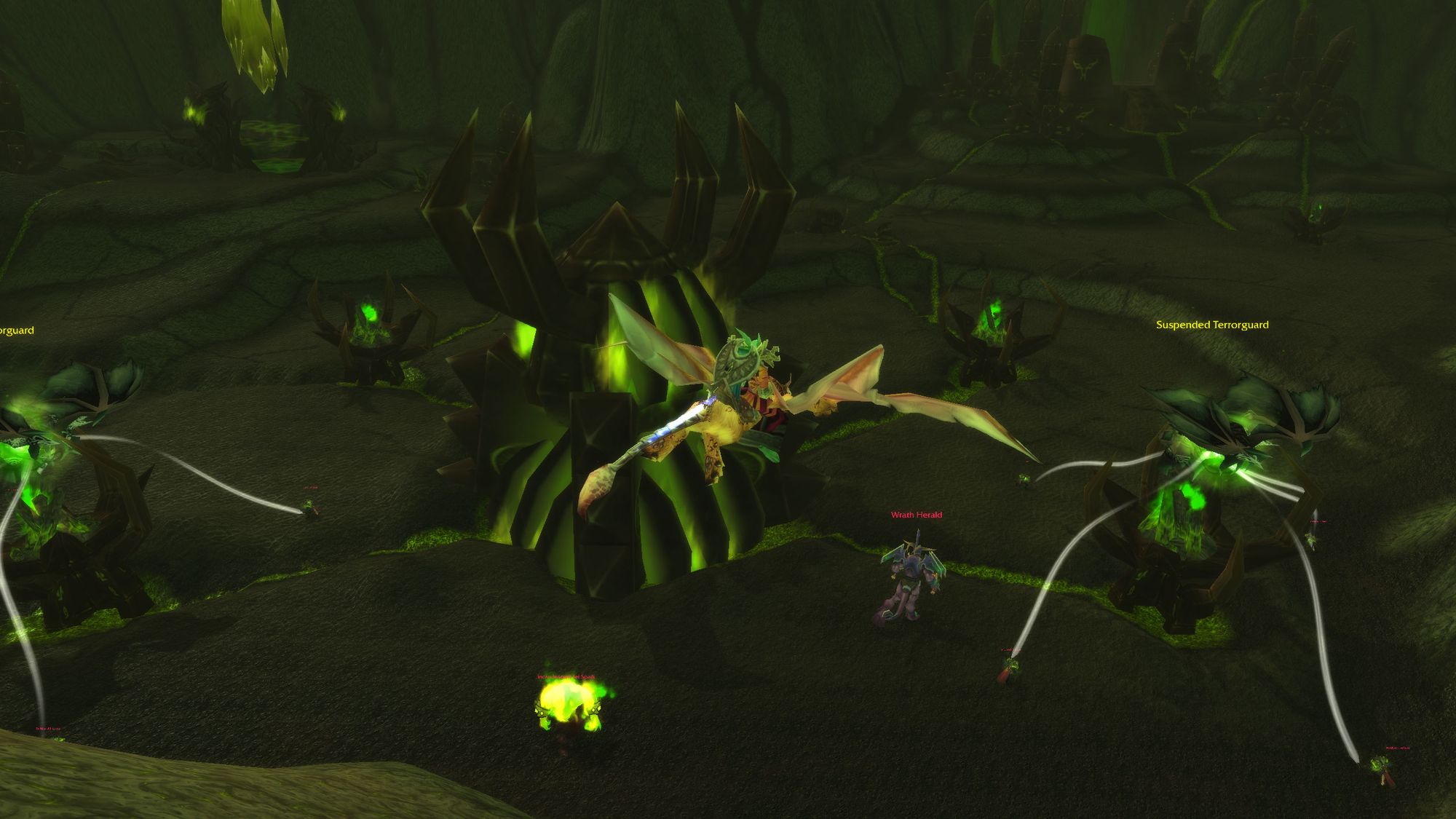
(Editor's note - In Phase 5, there's two new dailies here which meant competition for Primal Fires, when farming here, was a lot higher. You could still farm them in Nagrand, but their spawn rate is much lower.)
For Primal Waters, they're farmed up in Skettis, the future site of the Skettis dailies (more on that later). The lake is full of Skettis Surgers, who dispense Primal Waters at a reasonable rate.
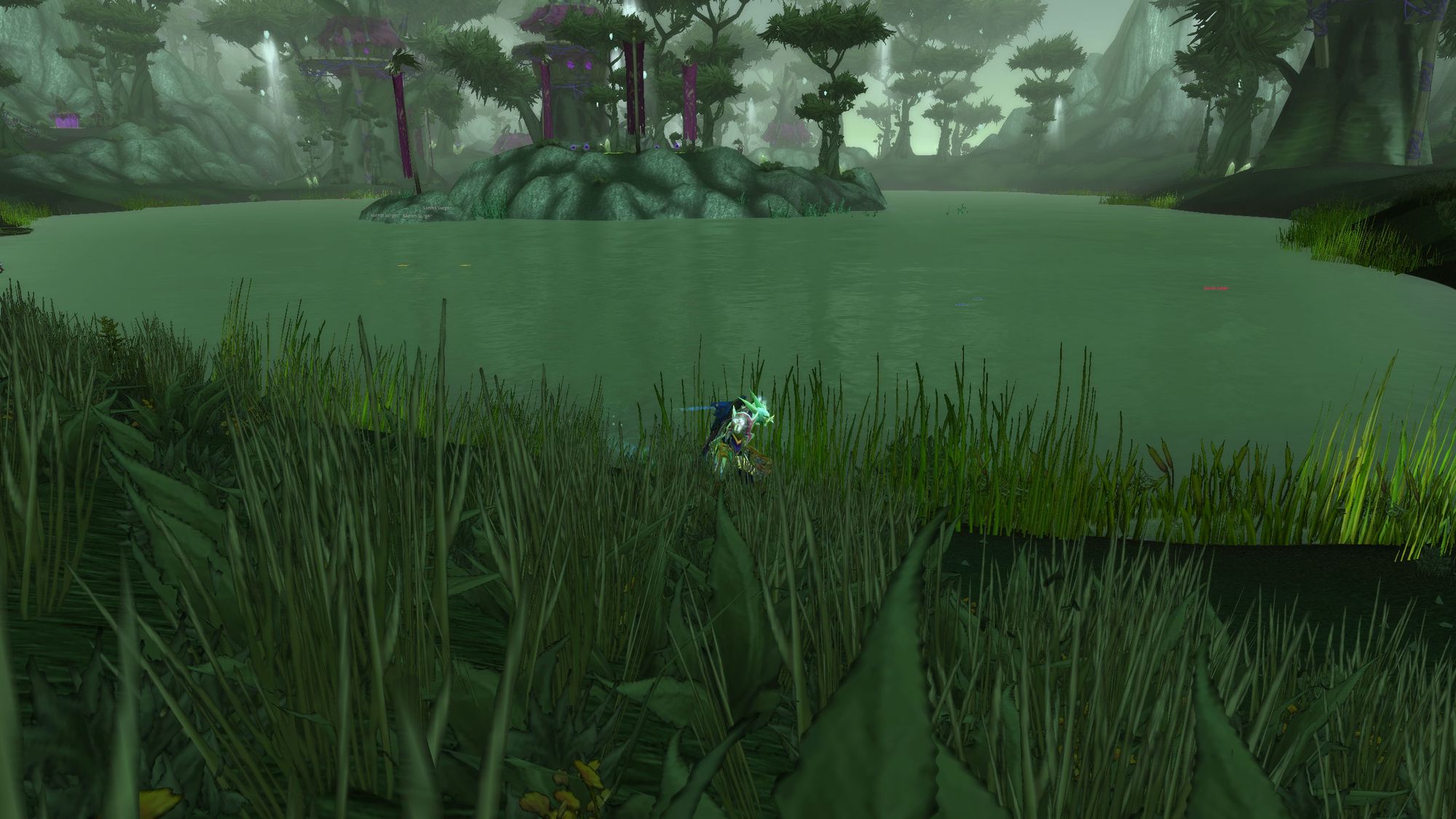
Early in phase one, noted Marbles curmudgeon Blackend (that is spelt correctly, according to him, anyway) farmed and sold enough primal waters to buy his epic flying (5000g - you do the math on how many primal waters, at 20g a pop.)
Lastly, in a farming path near and dear to my heart, there was Primal Manas. They were used for the very first set of crafted epics I made - the Netherstrike set, which was so good it was better than the chestpiece, braces and belt of any boss in phase 1.
Farmed in Netherstorm, you could either go to Kirin'var Village, which was often highly contested.

Or you could go on a big lap on the Area 52 island, which was my personal favourite. Just, steer clear of the Arcane Annihilator! Or, in Phase 2, when your new guild was taking on Lady Vashj, use it to practice Strider kiting.
Reputation items were also pretty big. Most players now want Aldor reputation, because of the higher base values for their shoulder enchantment, as opposed to the Scryers which had better critical strike values and a very important item for hit-oriented casters, (Editor's Note: Not Shamans) the Scryer's Bloodgem.
Fel Armaments and Marks of Sargeras, used for Aldor Rep, could be farmed in Shadowmoon Valley, but unless you had reasonable gear, you'd have a very real chance of being overwhelmed by the high spawn rate AND the prevalance of a level 70 elite.
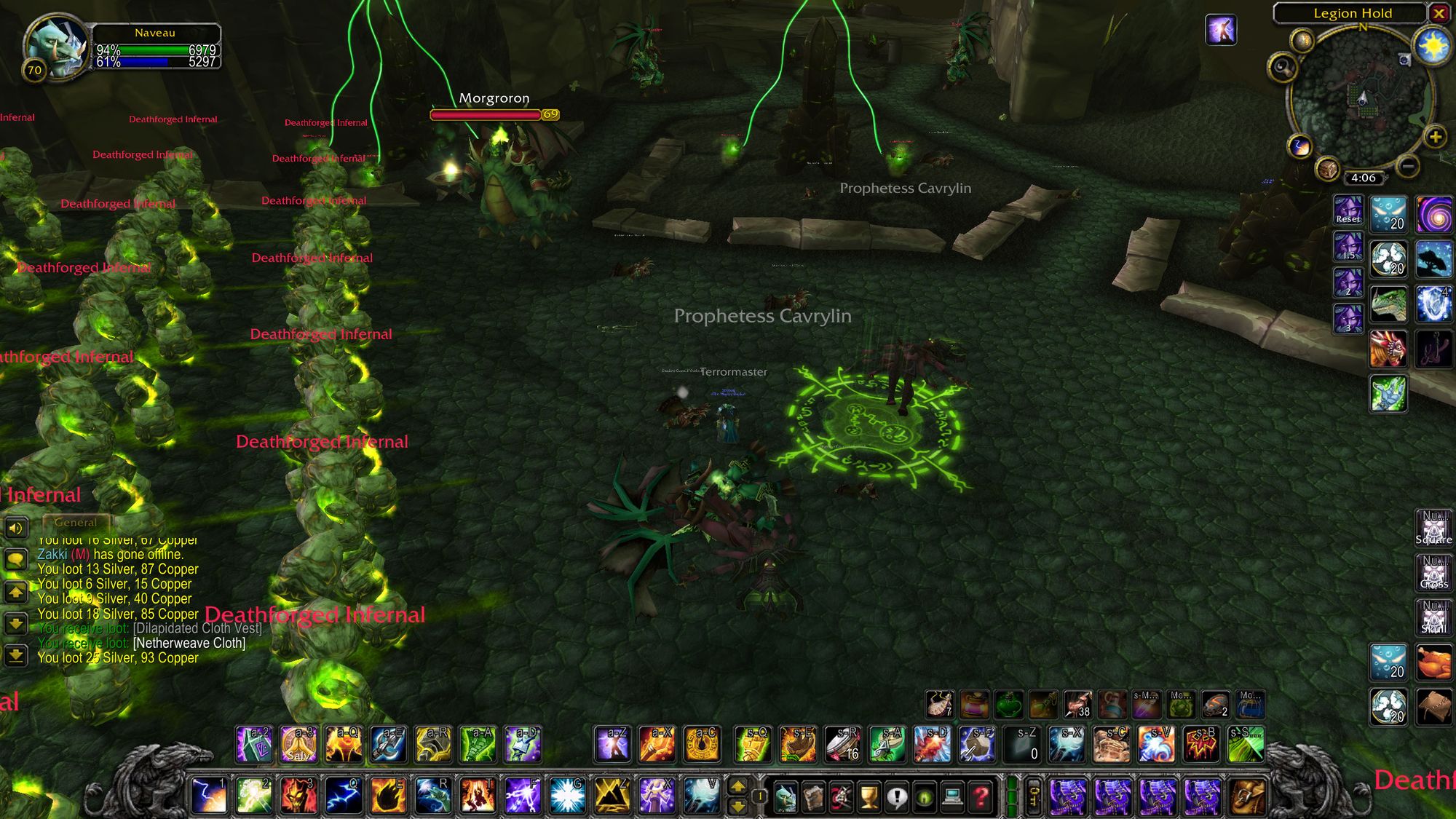
For Arcane Tomes and Sunfury Signets, used for Scryer Reputation, you could farm them at Manaforge B'naar. But again, watch out for that cheeky Arcane Annihilator!
There were also food items to farm - in particular, Blackened Basilisk (spelt correctly) which was farmed from Zangarmarsh and sold in vast quantities to folks who were only logging on to raid and couldn't be bothered to gather their own raid consumables. Just like me, in the end.
There were also the profession specific materials. Terocone, a key ingredient in healing and physical damage classes, stayed consistently expensive through the entire expansion, due to Blizzard being unable to come up with a flask that increased healing power. For a while, Nightmare Vine, a key ingredient in Destruction Potions, sold very well, and Dreaming Glory, used in Super Mana Potions to keep your casters topped up with the blue stuff.
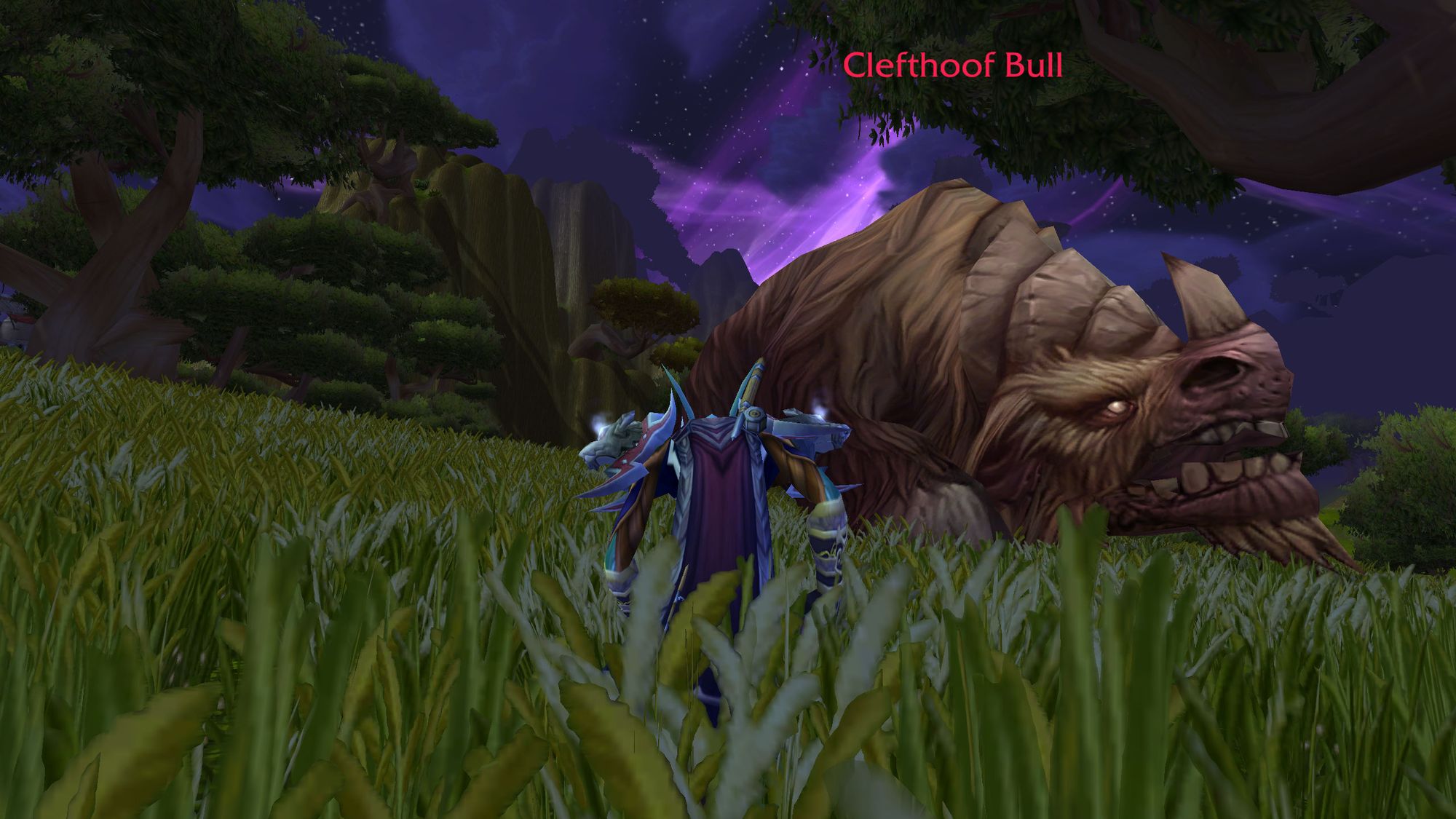
For a brief period in phase 1 and 2, leather (particularly Heavy Clefthoof Leather) sold very well, as most raid groups required a large number of drums of battle, due to the short radius. Once phase 4 came out, and you could cover your entire raid group with greater drums, the need died off. In addition, most crafted Druid and Shaman leatherworking items (remember the Netherstrike set? I do.) required a significant amount of leather to make.
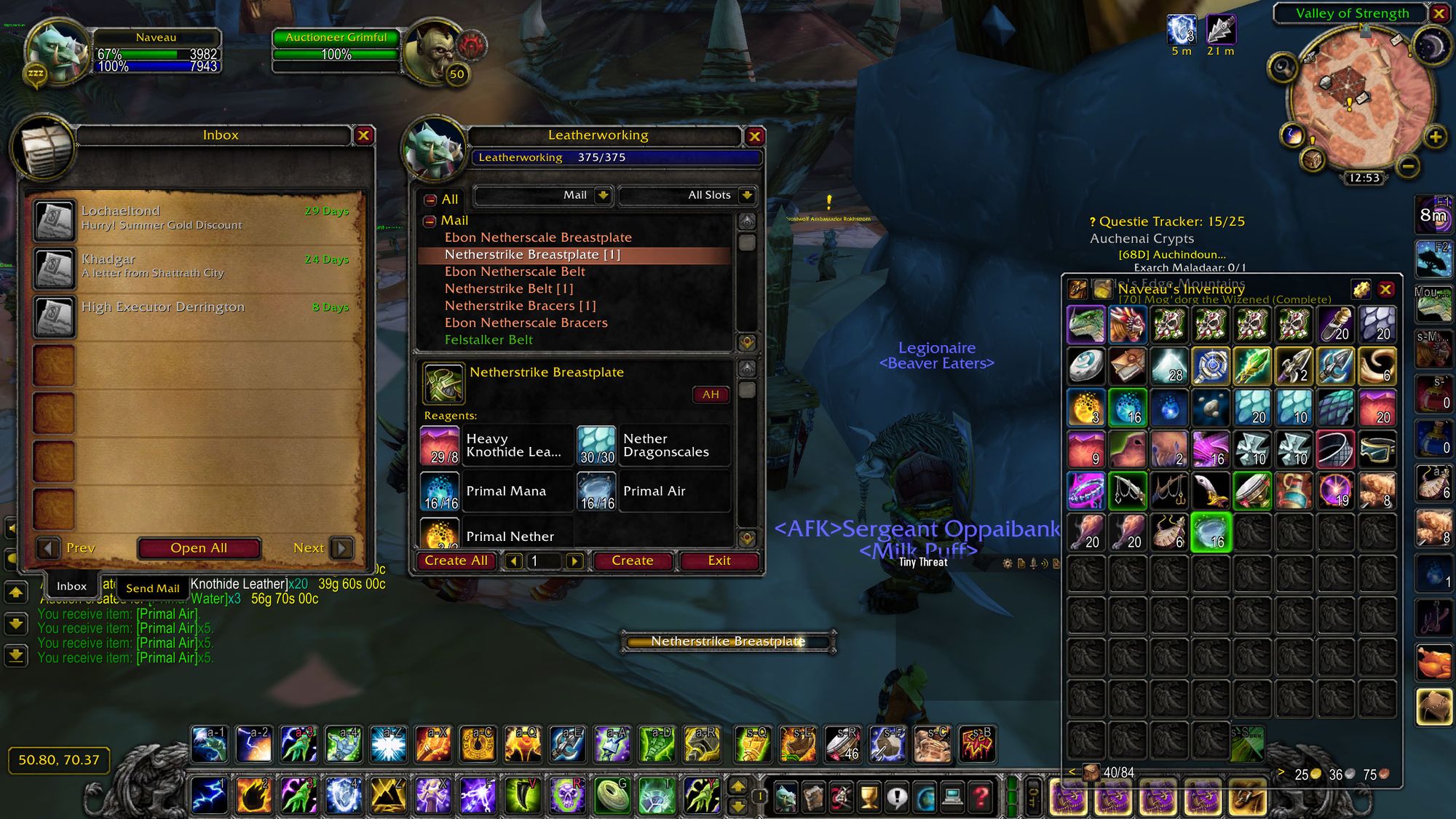
There was also an even shorter window where Nether Dragonscales, dropped from skinning drakes in the back corner of Blade's Edge Mountains, sold like hotcakes. I remember selling a single stack which I farmed in half an hour for 100g, and then never sold another one after that.
Moneymaker No. 2 - Dailies
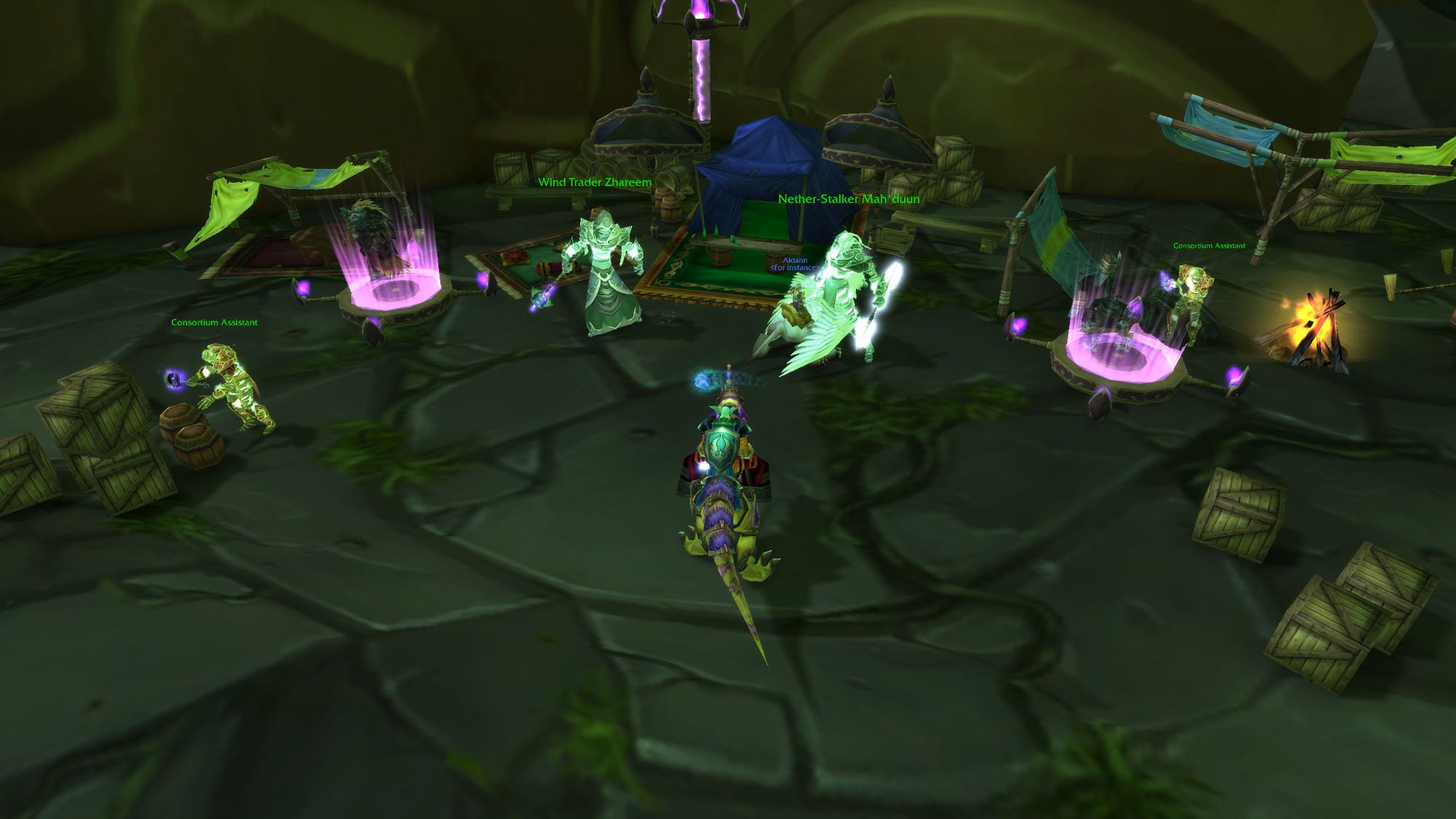
At the launch of TBC, there were four daily quests. - the cooking daily, fishing daily, daily normal dungeon and daily heroic dungeon. For the uninitiated, you could do each of these quests once per day, for a gold reward. I know that seems obvious, but, you know.
The profession quests were easy to complete, but you might be waiting awhile to find a group for the normal dungeon. Remulos' low population combined with a tank shortage meant forming up represented a significant time investment, often far outweighing the gold requirement.
The daily heroic was the most rewarding, but also the most difficult. First, you required a hefty chunk of reputation (Revered, which is the penultimate tier of reputation) and, depending on the dungeon, you had to have reasonable gear and a proper dungeon composition. Many a night outside of raid was spent smashing my face into genuinely difficult heroic dungeons like Shattered Halls and the Arcatraz.
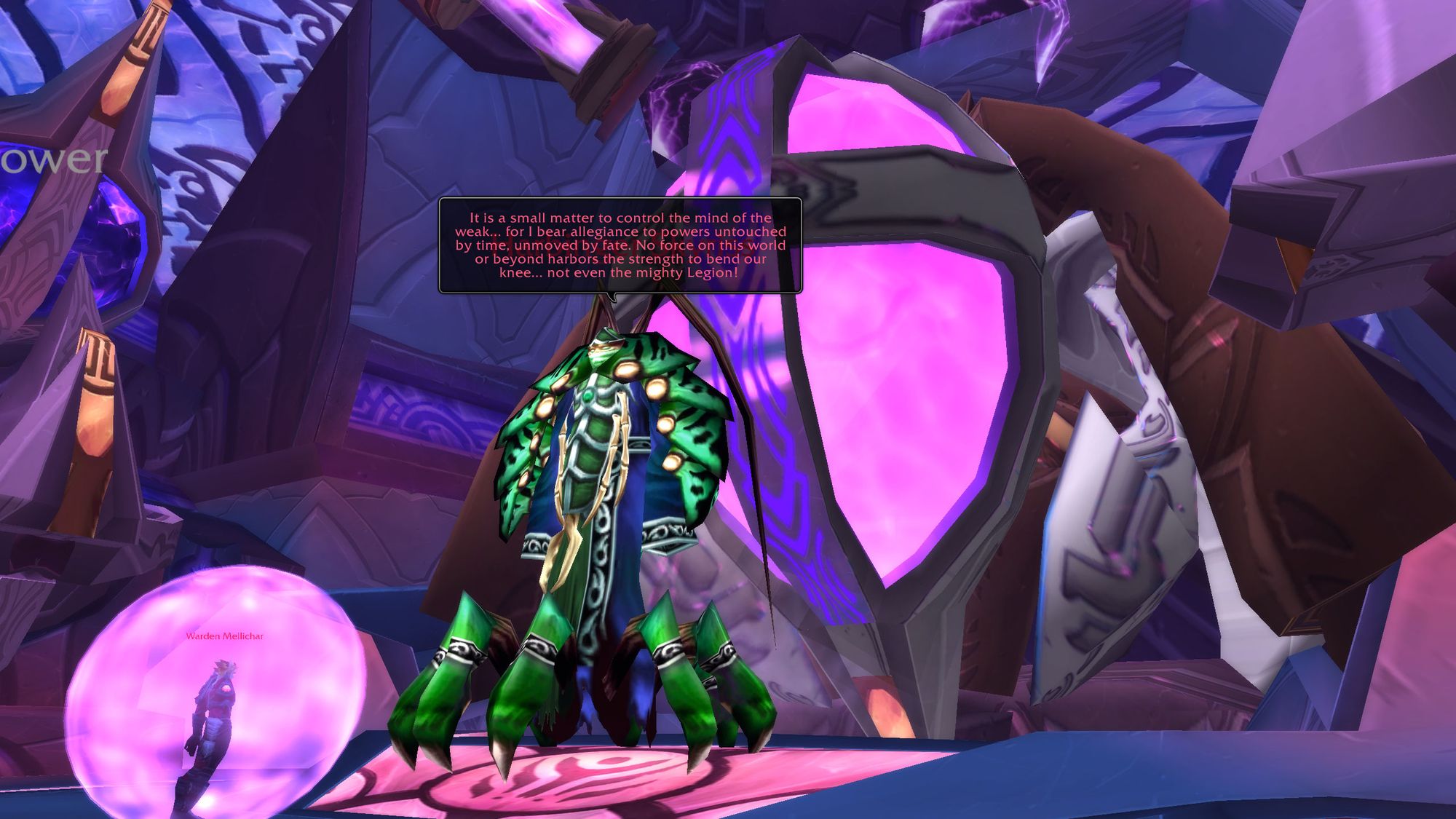
Eventually, Phase 2 rolled out and along with the Serpentshrine Cavern and Tempest Keep raids, we got given access to our first wave of quest dailies: Ogri'la and Skettis.
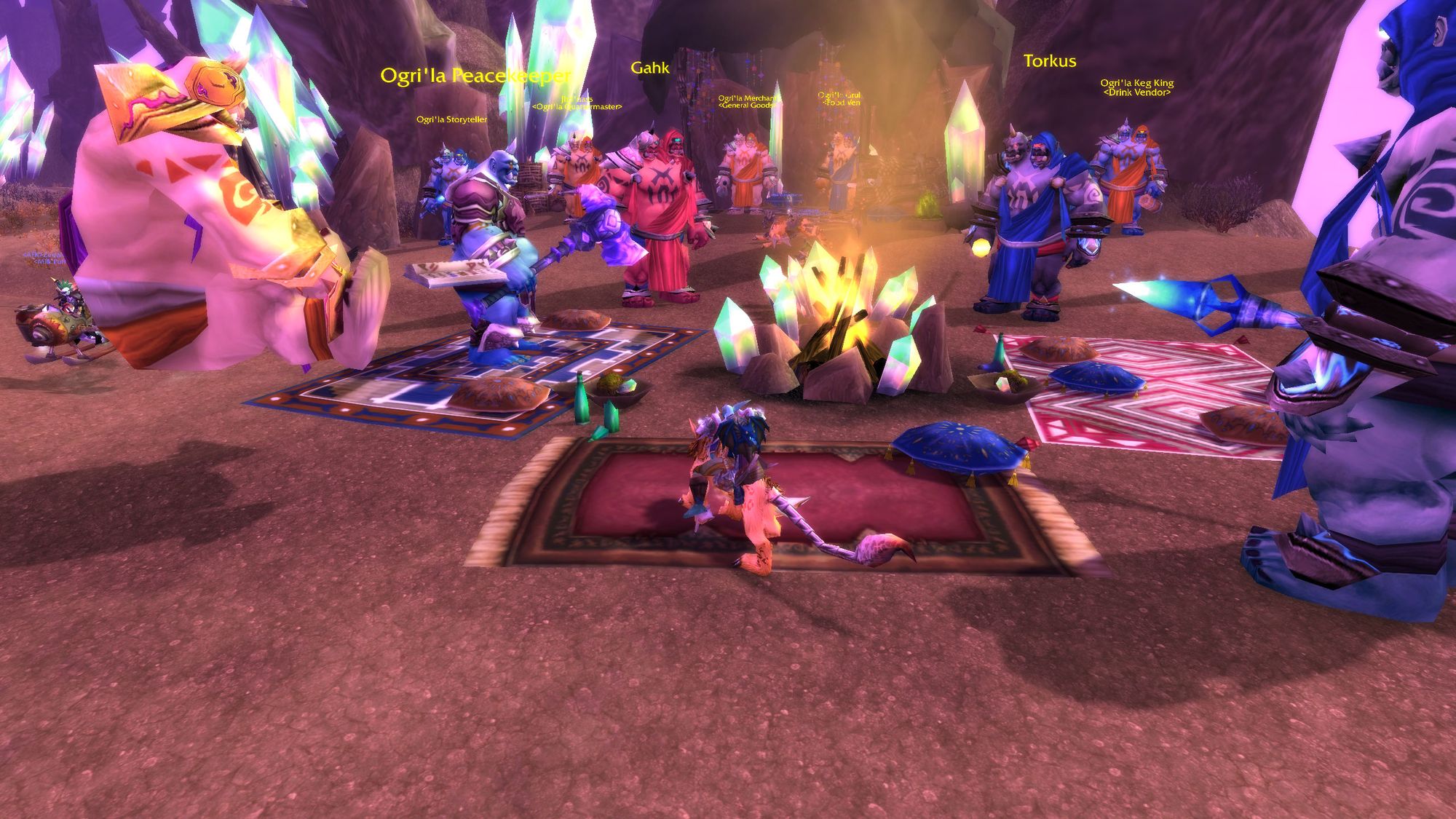
Because TBC was about making you work to unlock stuff, to unlock the Ogrila dailies, you first had to kill five elite Gronn. Nevermind that you had already put Gruul into an early grave last phase, this phase you needed to deal with all of his offspring. You could also have done it in phase one, I suppose, to preserve continuity.
A quest in Shattrath City sends you to the Blade's Edge Mountains to see a gentleman ogre by the name of Morg'dorg. He tells you about how much he hates the Gronn overlords who control the Ogres (well, some of the Ogres) in Blade's Edge.
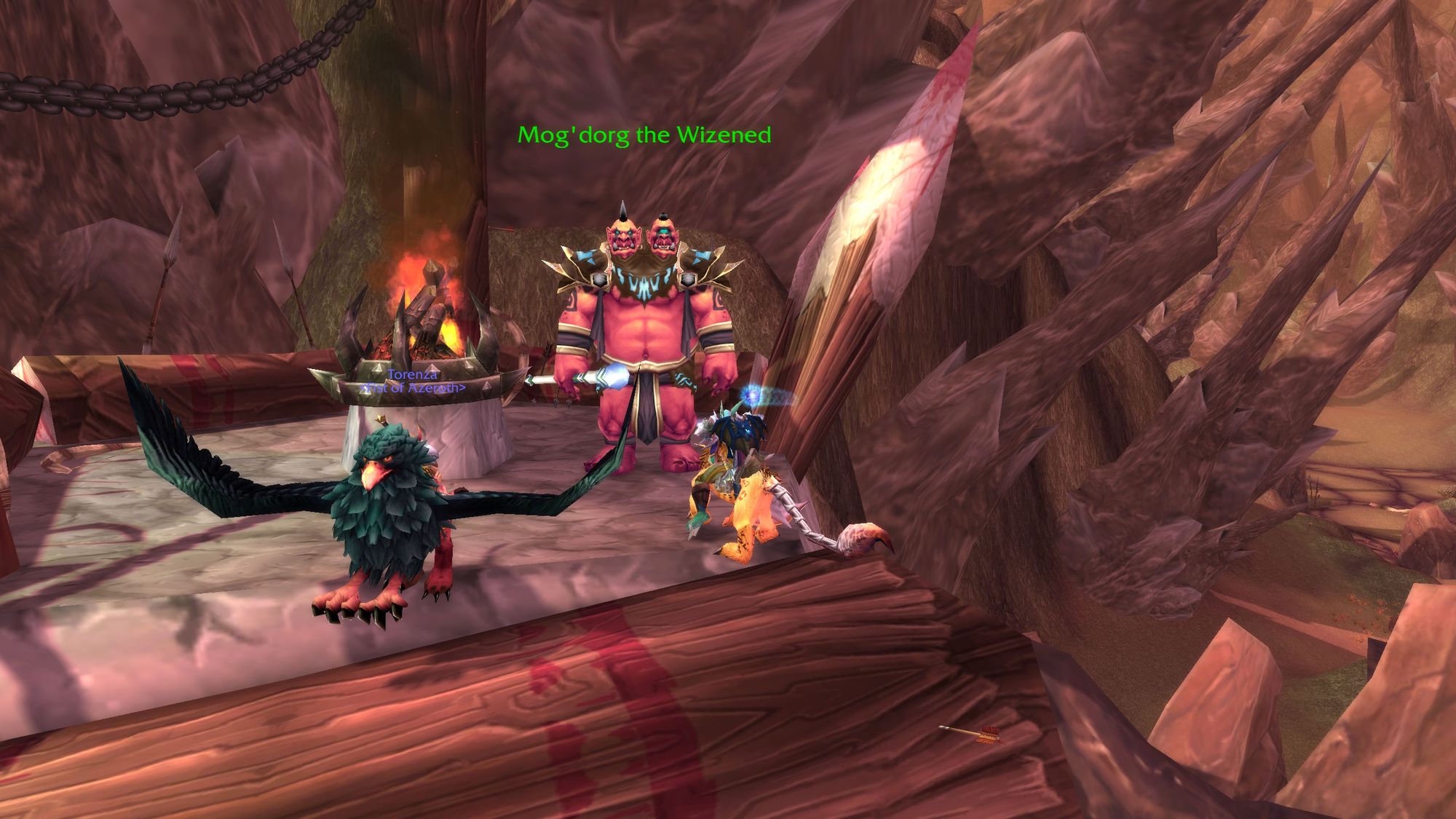
He sets you three initial targets, which need to be completed in groups of three or more, preferably with at least a tank and a healer. Slaag (who is actually up in the barrier hills about Shattrath City), Maggoc, who wanders the ridge above the Cenarion Expedition village and Grulloc, who has two skulls. You're going to relieve him of his.
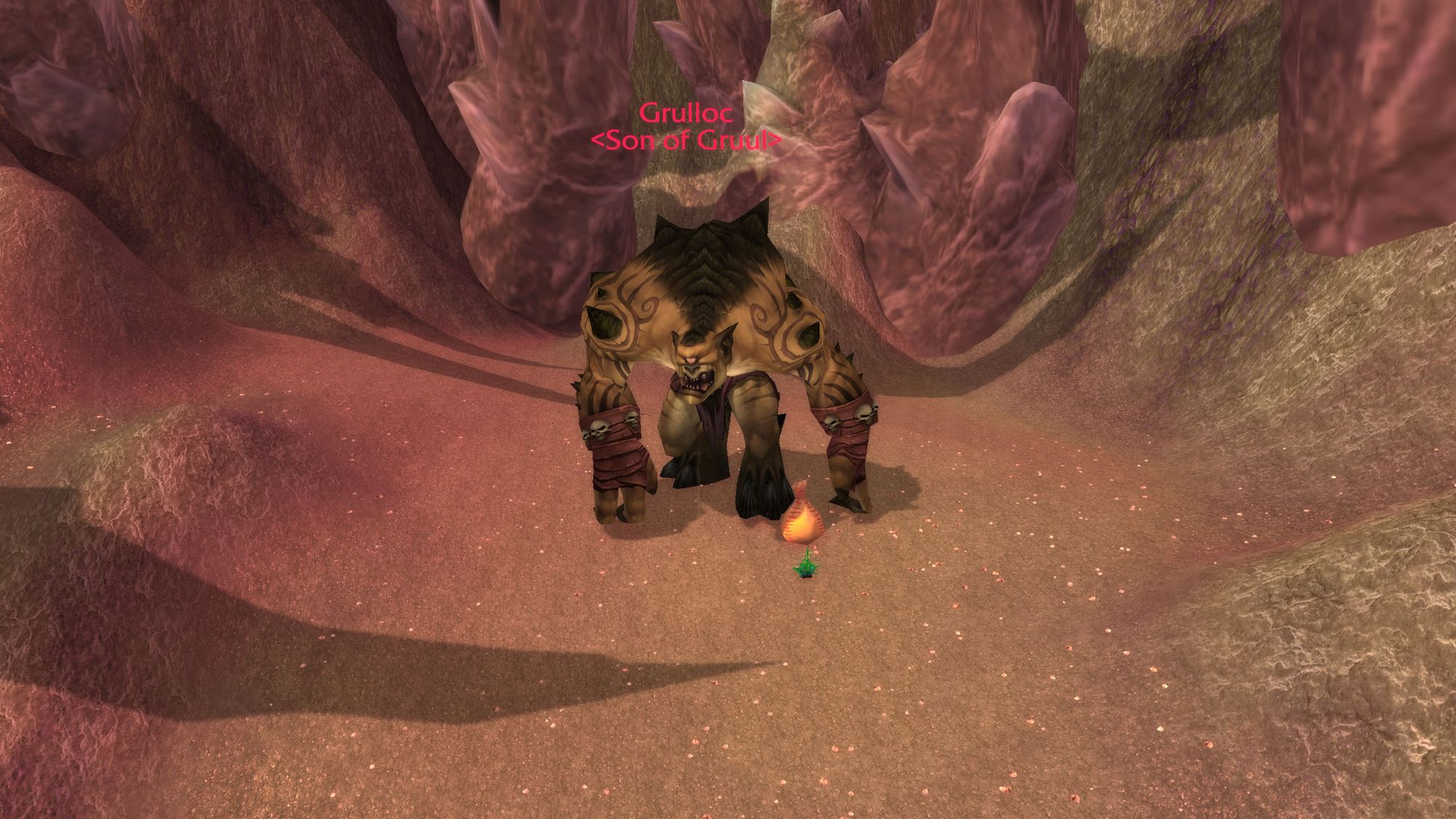
After you kill those three Gronn, he then sets you an additional target - Vim'gol, who is not a gronn, but a powerful ogre mage who threw his lot in with the Gronn. This quest requires five people, as to summon Vim'gol requires all players to stand in five pre-placed spots to create a pentagram.
Show him the sky and then you have one final quest - Skulloc. You go and kill ghost ogres using Vim'gol's grimoire, until Skulloc shows up.
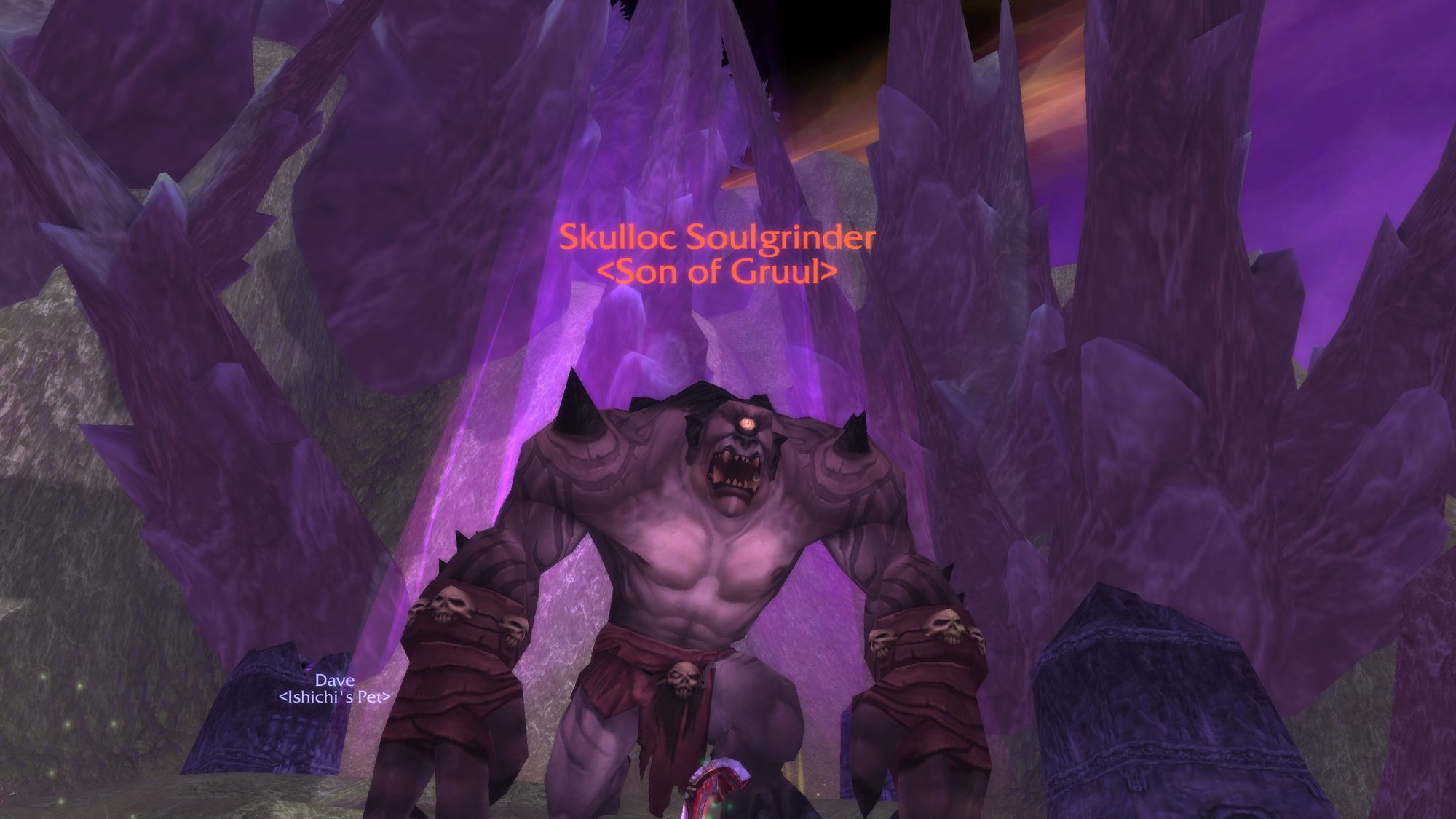
Then you kill him.
After killing these five gronn and returning to Morgdorg, the Bloodmaul Clan of ogres gathers to hail you as their new king. To quote the Offspring "I just work here, man."
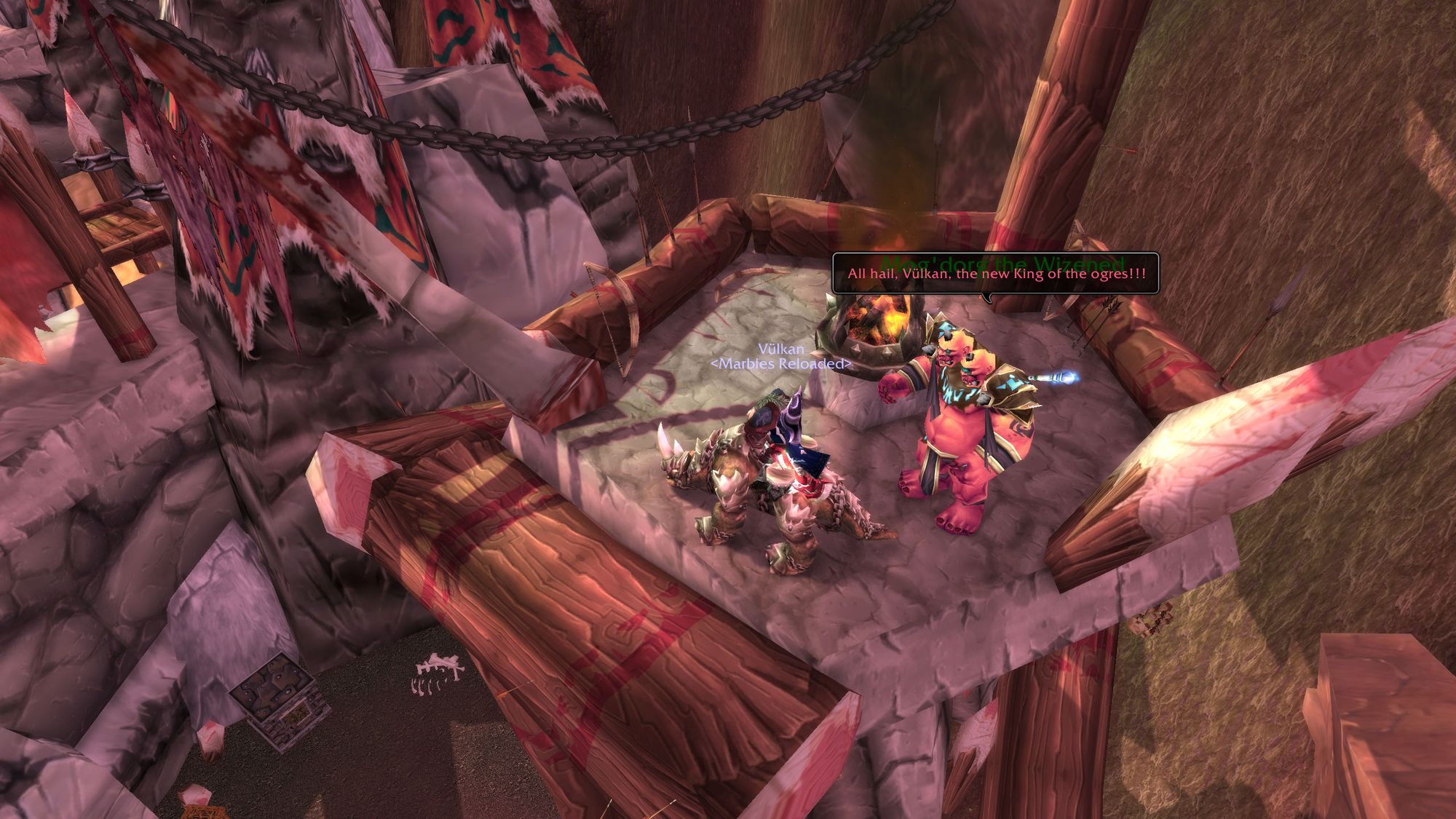
But, critically, this little set of quests (which I must've done three, four, five times for different players and alts through the expansion) unlocks a big chunk of the first set of dailies, Ogri'la.
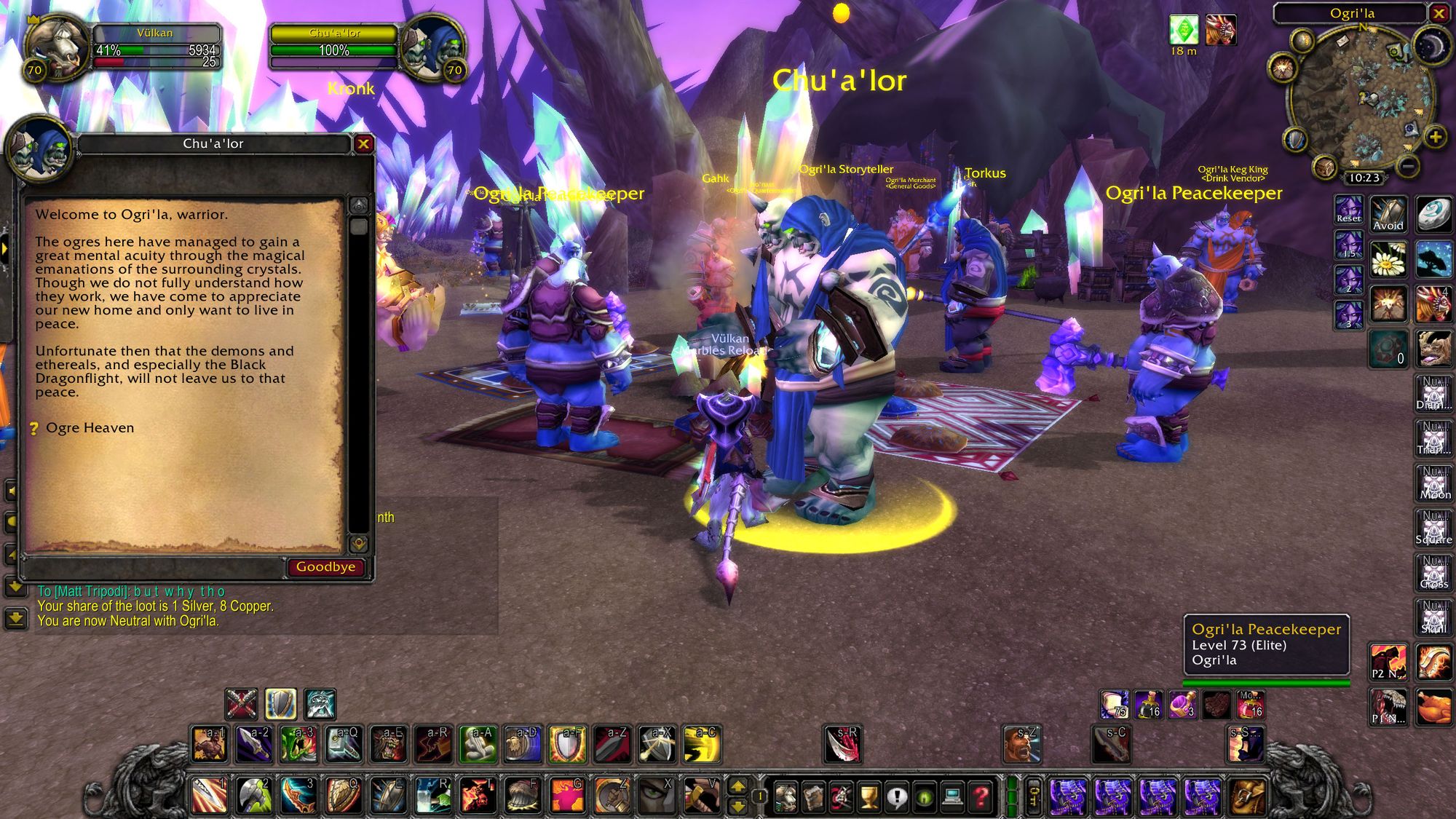
Requiring a flying mount to access, the Ogri'la dailies are an interesting mix. You can tell Blizzard was flying by the seat of their pants here. There's a certain feeling about being on the cutting edge (at the time) of Blizzard's design ethos.
There's all sorts of one-off quests, such as how to get Blade's Edge only flasks and mana potions for Apexis Shards, a quest reward and occasional drop from mobs, as well as quests for the different bigger enemies you can kill to get Apexis Crystals to turn in for gear.
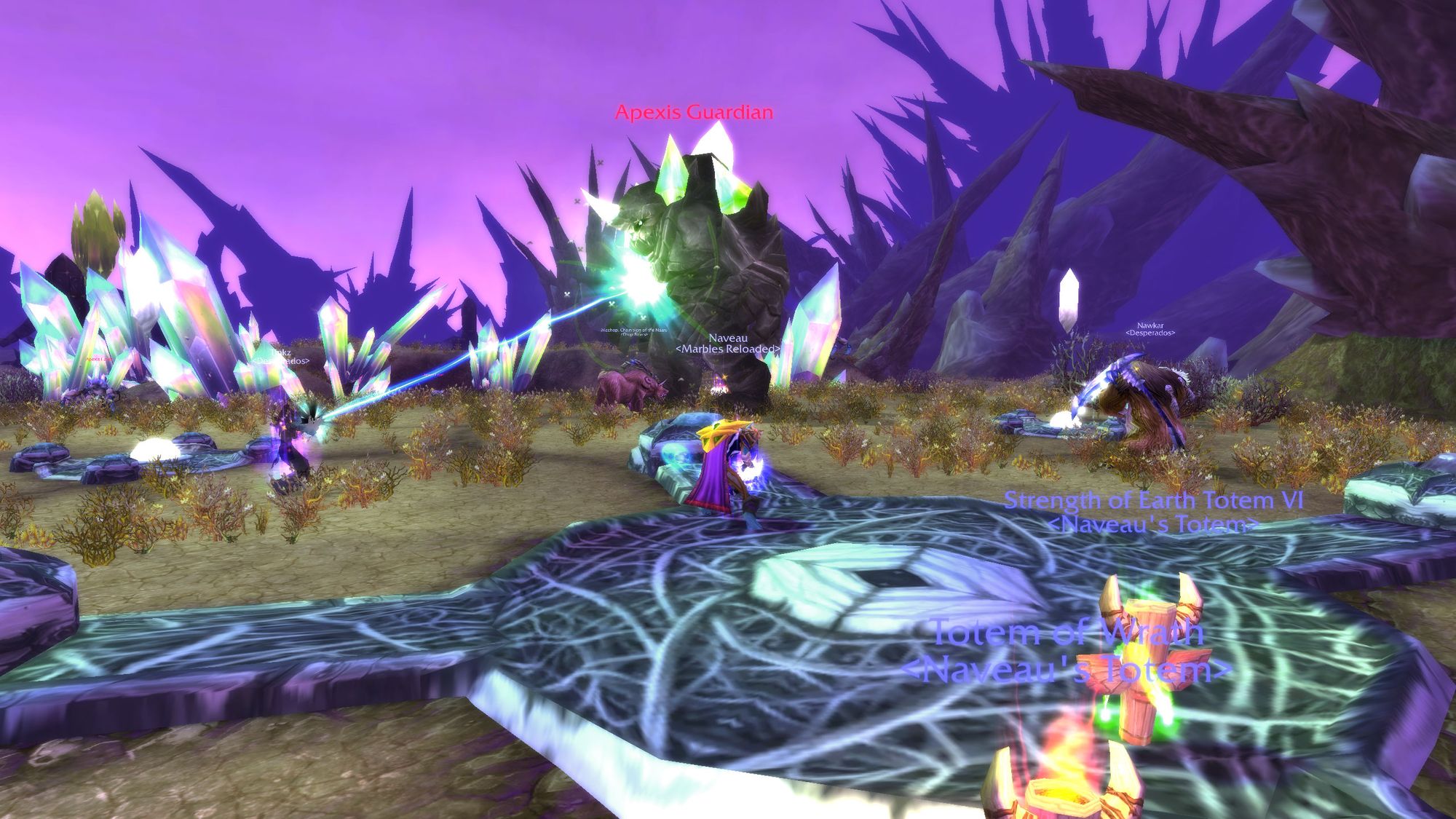
(Editor's note: That gear sucked on day dot, by the way. No-one I knew used the Ogri'la gear. But it was there if you ground all the way to exalted and then killed countless dungeon-boss tier enemies for apexis crystals and shards.)
As a fun little aside, when this block of content first released, there was a bug with the flasks where the game didn't take the currency, so you could take as many crappy Blade's Edge flasks as you wanted. At the time I was Guild Leader of Marbles Reloaded and a whole bunch of my core 25-man raiders got banned, a day before raid, including a warlock and our main paladin tank at the time.
You can even find the thread I made on the wow forums, asking for some of the bans to be reduced, I was that desperate.
Once you had all the dailies unlocked, there were five dailies in total. This also required you to grind reputation with the Sha'tari Skyguard, a faction based in Terrokkar forest, who had a base next to Ogri'la. Once you had high enough rep, you could fly between the two Skyguard bases.
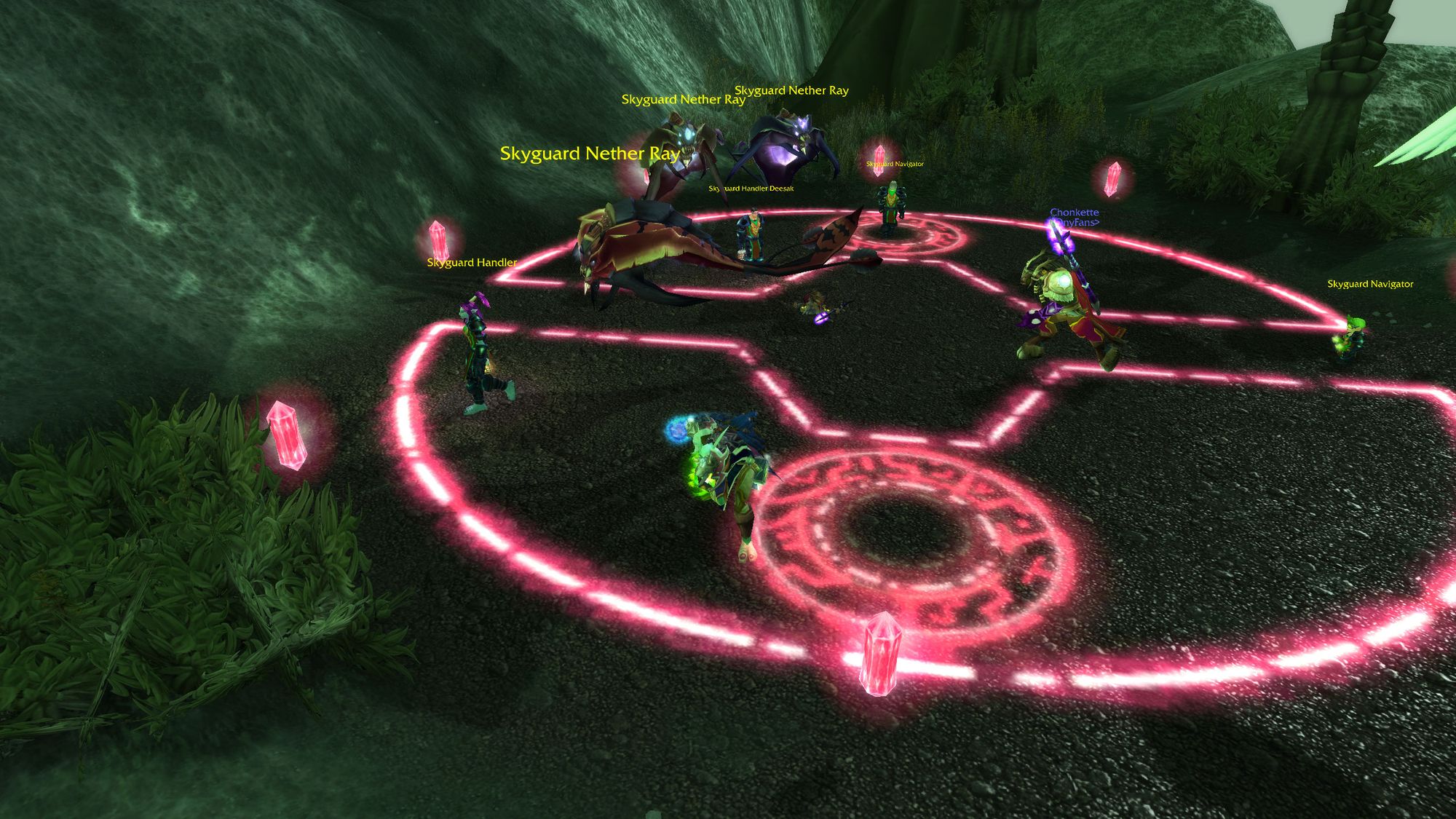
The first of two Ogre dailies required you to play simon says with a mysterious crystal. Get the pattern right enough times and you'd get a Blade's Edge specific buff that increased your movement speed in the area. There was an addon you could download (which I did) called "Ogri'la Stone for Dummies" which allowed you to track which buttons to press.
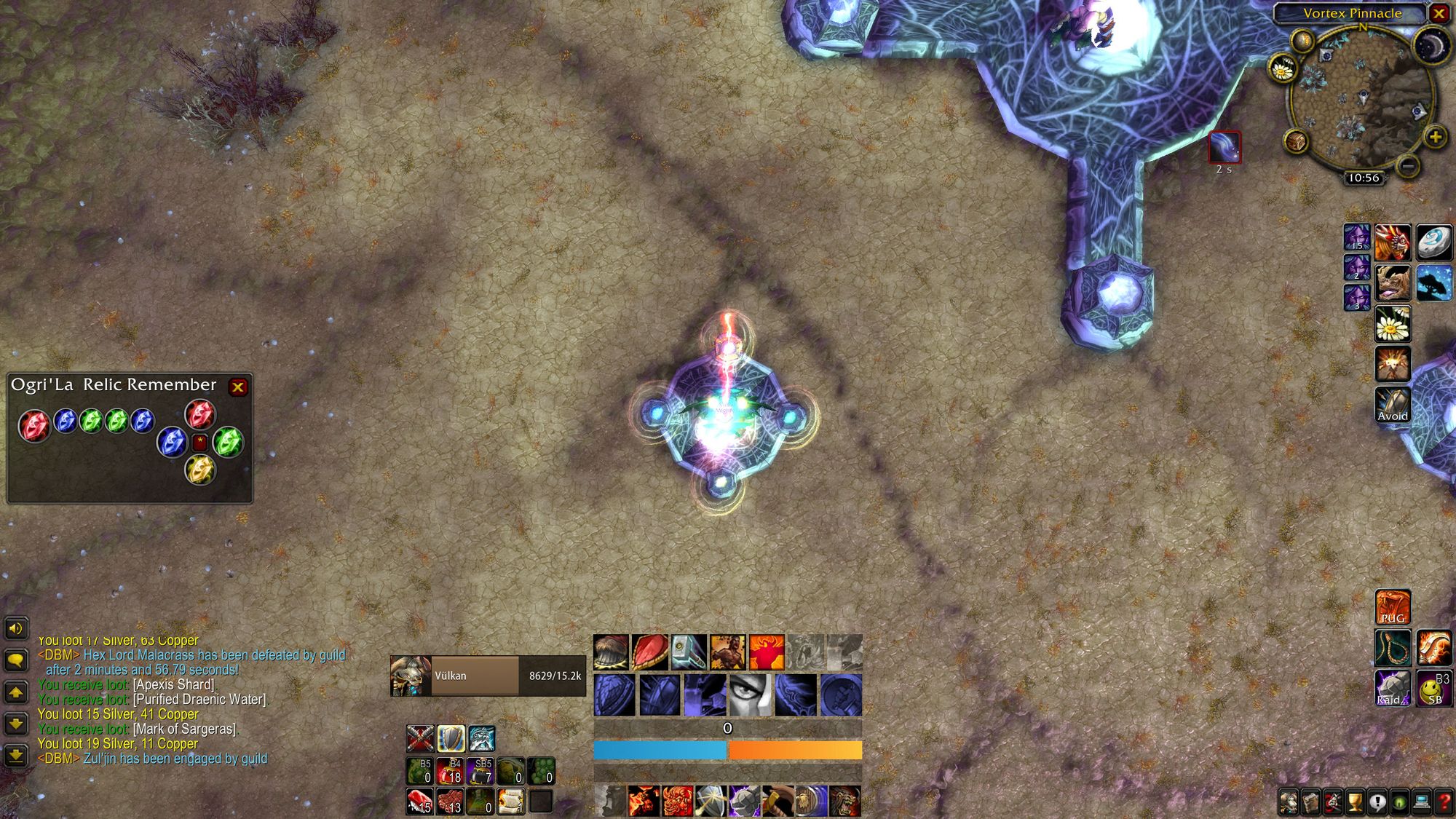
The second quest involved setting up a portal at one of the Forge Camps to the north or south using Apexis Shards. For those with short memories, Apexis Shards were the currency of the area, so if you were trying to save shards, you would want to be conservative. You lured demons close enough to be sucked into the portal when they died, then... killed them. Of course, not all the enemies were demons, so you had to pick your targets carefully. And if you were playing a oneshot caster merchant like an Elemental Shaman (me) or a Warlock, you had to let them get close before opening up or you wouldn't get credit for the kill.
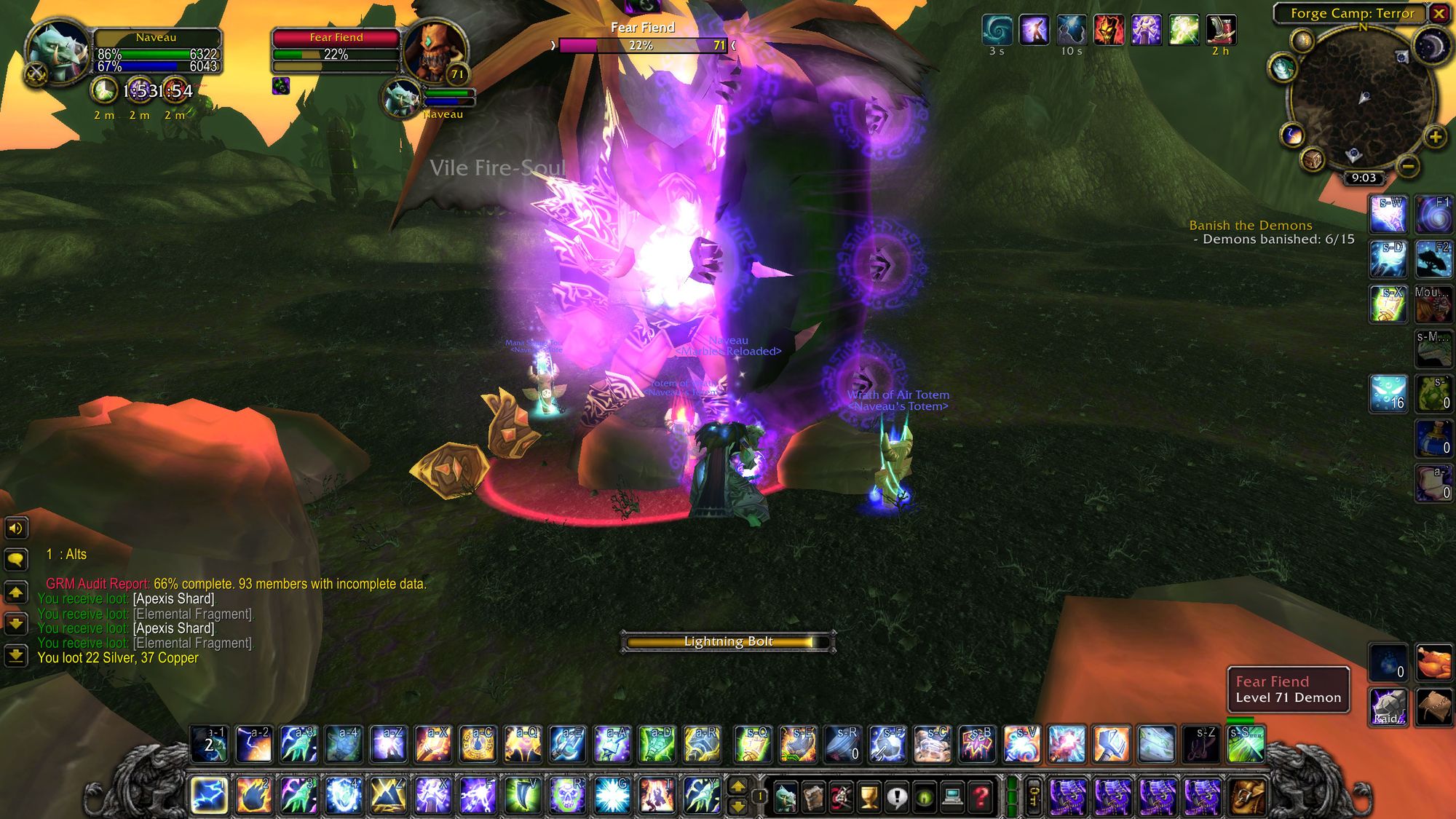
Turning in this quest gave you access to the fifth daily. You would get a bag of loot that give you either a Darkrune or Darkrune Fragment. You could then turn this into the Ogres to get a Crystalforged Darkrune, which you could then use to possess the Felguard Degrader in the north of the area.
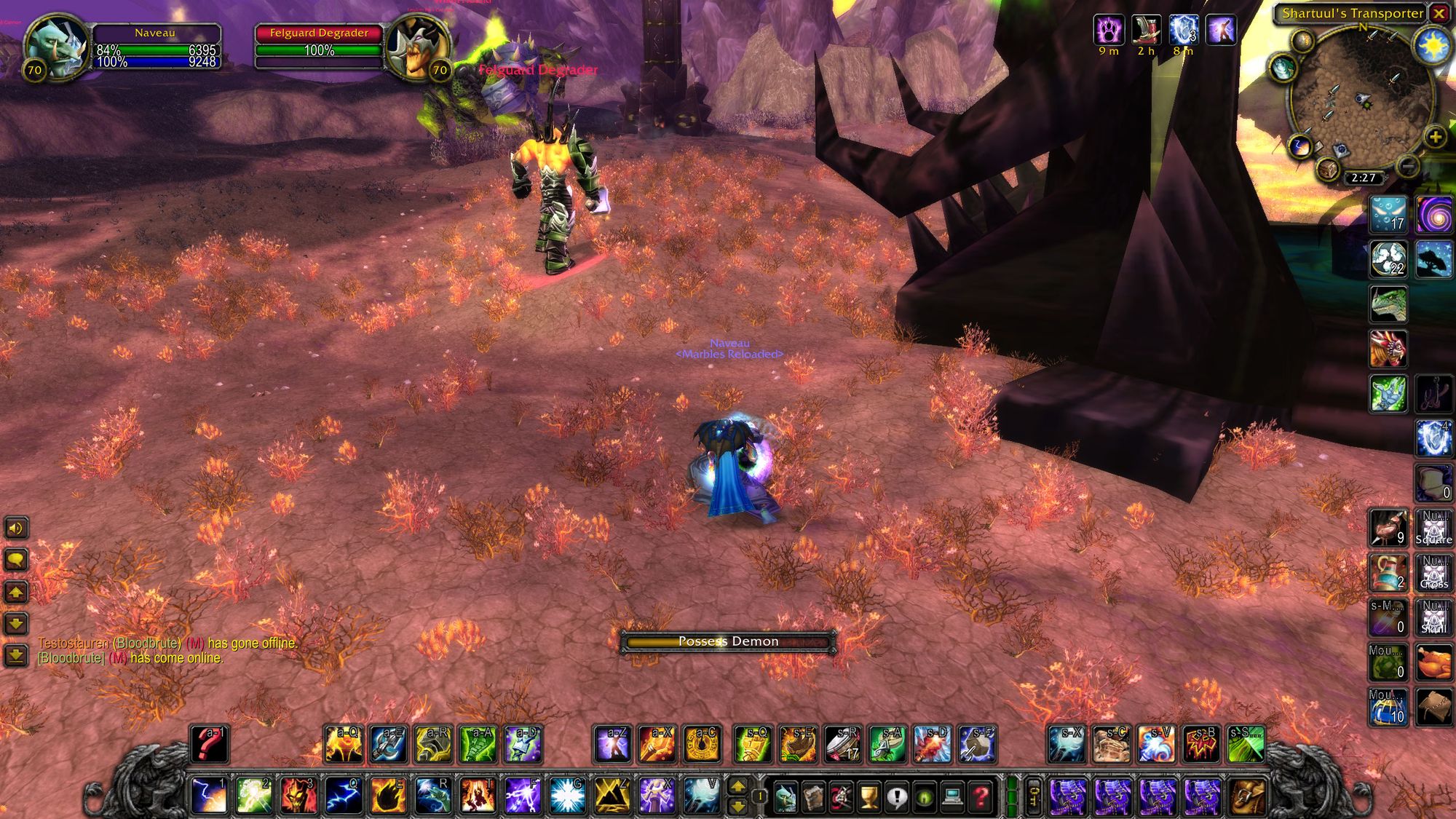
This quest is a precursor to the vehicle segments found in future expansions. You would control the demon and only the demon using a pet action bar, much like the Karazhan Chess game. You then fight waves of demonic enemies, culminating in a boss demon, that you kill, possess and repeat until you defeat Shartuul, the demon responsible for the creation of the demonic teleporter in the first place.
Here's a guide I used to learn how to do it.
This quest doesn't reward you with gold, but does reward you with a number of items that are quite useful. Or, were. In particular, Paladins would like the Crystalforged Sword, which was a defensive spellpower weapon:

And druids wanted the badge of tenacity. A particularly sweaty (and lucky) player on our server flipped over this item on day zero and managed to sell it for nearly 2,000 gold.

The two additional Sha'tari Skyguard quests tie in to the two Ogri'la quests. The first is a quest to wrangle aether rays, which is in the same general area as the Ogri'la stone. It's simple, but sometimes quite infuriating. You have to reduce an aether ray to less than 40% HP and then use an item to capture it. Eventually my gear powered me up so much I had to do this quest without pants, because I could occasionally oneshot the aether ray and have no chance to catch it at all.
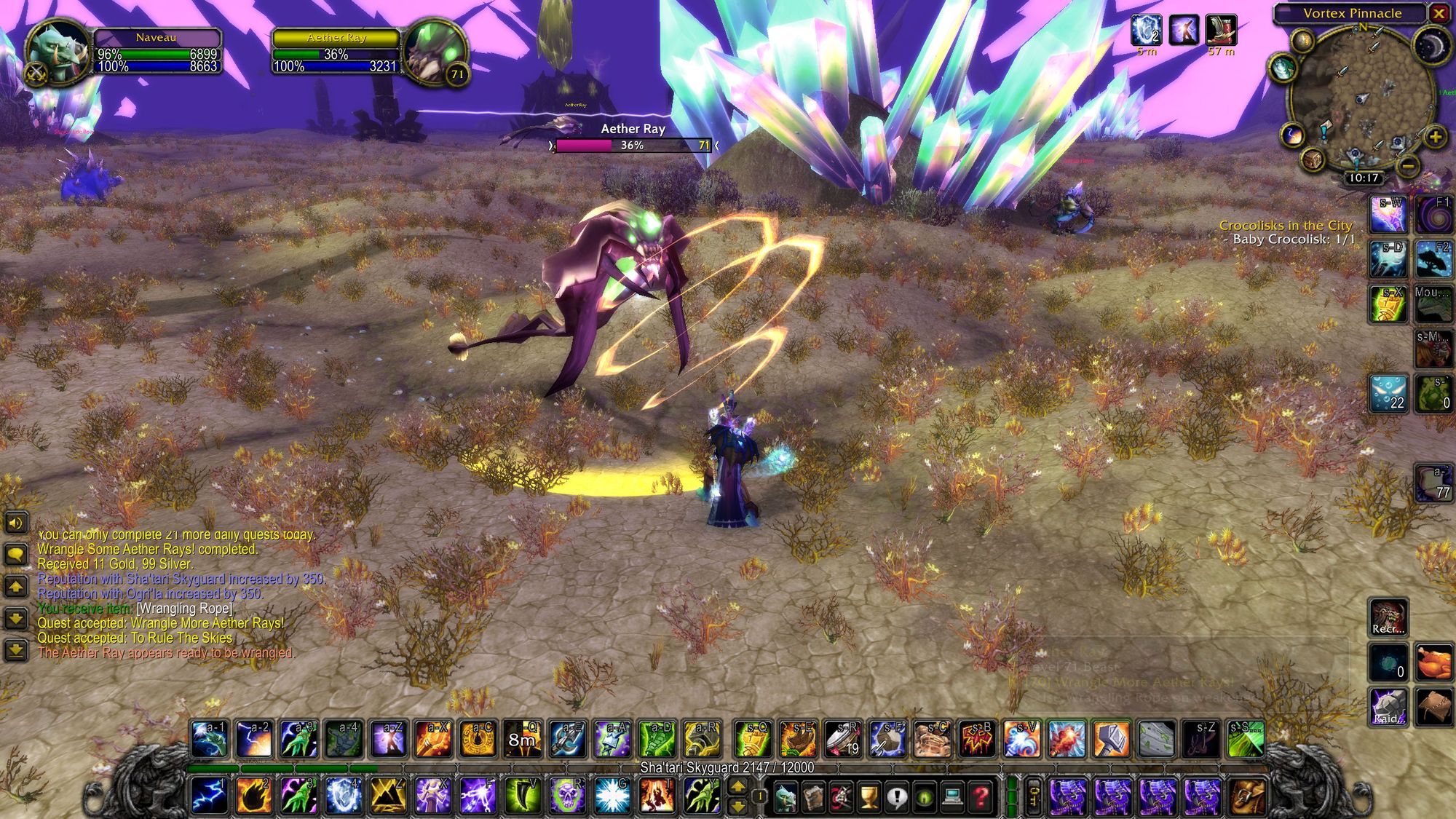
When Ogri'la was particularly busy, some particularly vengeful players would kill the aether ray whilst you were trying to catch it.
(Editor's note: A fun little side note here, originally the particle effect for the wrangling rope was a glowy laser beam - in later phases, the particle effect became a rope texture.)
The fourth quest tied in with the second ogre quest in the forge camps to kill demons. Using an item provided to you by the Skyguard, you would go around destroying fel cannonball stacks. This didn't stop the fel cannons from shooting at you, just, you know, completed the quest. For a very long time the cannons were bugged though and didn't shoot at all. It wasn't until phase three with the next set of dailies, that this was fixed.
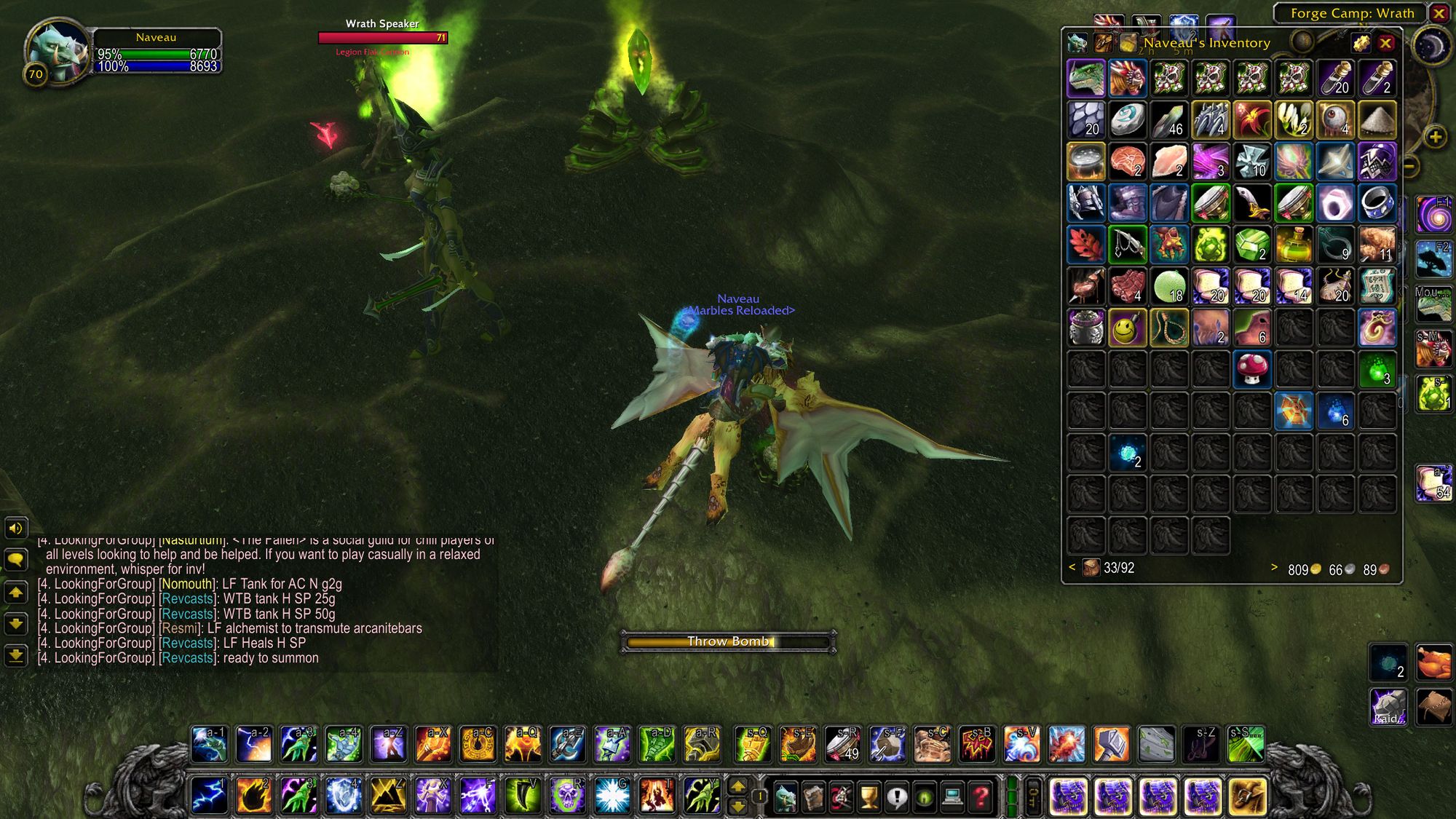
Because I was slack, I designed a mouseover macro to cast the Skyguard Bombs wherever my mouse was pointing. Nifty little trick.
Of course, to get those last two quests you had to get Skyguard rep. How did you do that? Well, you went and helped the Skyguard in Terokkar Forest, of course!
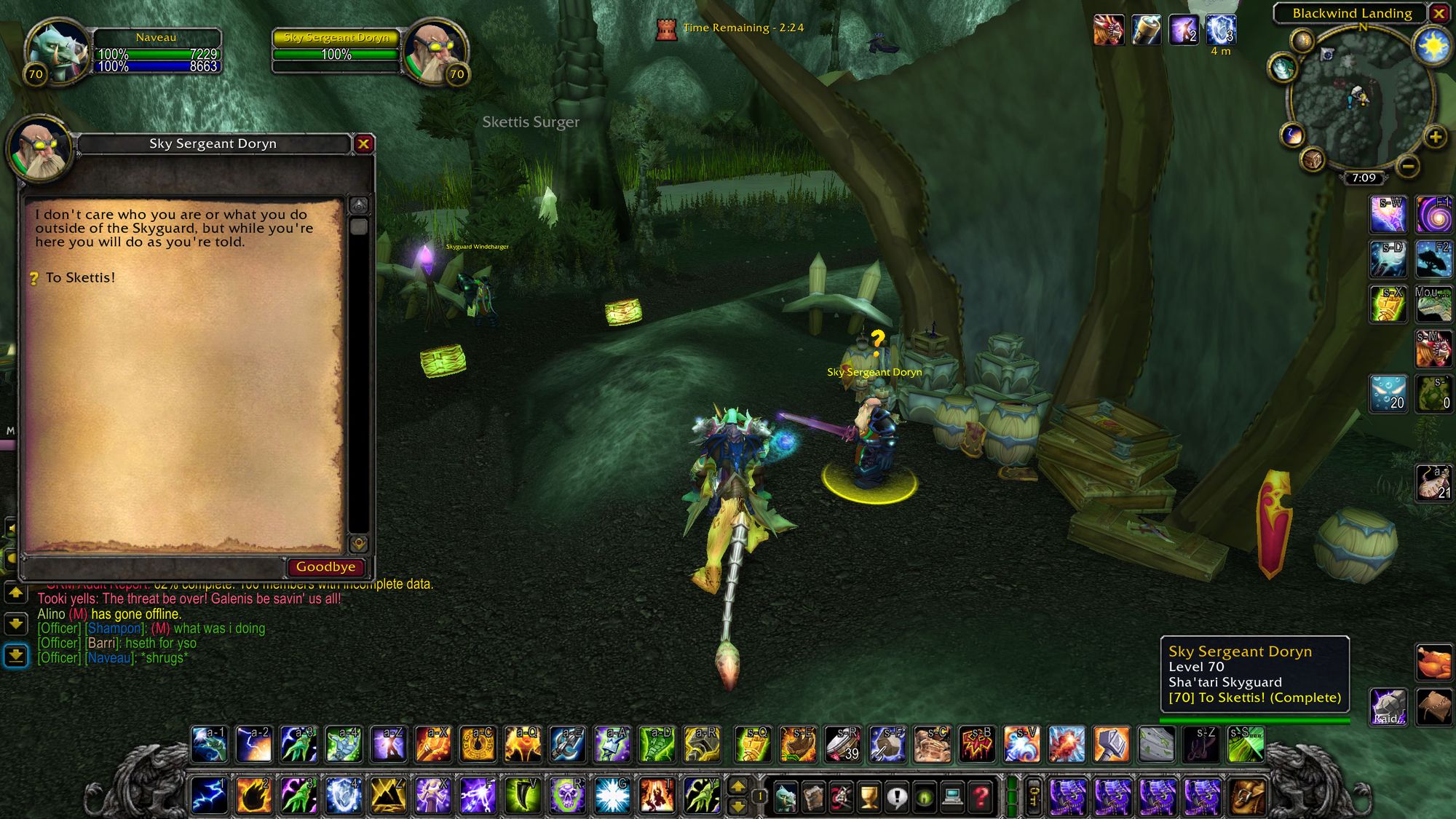
Much like the Ogri'la attune, before the Sha'tari will even look at you, you have to do something for them. Fortunately, instead of killing five elite mobs requiring five people, you just have to kill twenty ogres on a ridge above Shattrath City.
Of course, good luck doing this on launch day of phase two. I waited a fortnight before diving in to get it done.
Once that's done, they ship you to Skettis, where the Arakkoa birdmen are making trouble and it's up to you to help! Or, you know, everyone else on the server. Again, there's a series of oneoff quests to show you how the mechanics of the area work, which involves dressing up as a birdman, farming 40 scrolls from bird ghosts and finally, taking on the big boss bird god leader himself, Terokk, with a little help from Skyguard close air support.
It took a week for Blizzard to make the final quest completable, as halfway through your big bird battle, he makes himself invulnerable with a shield which requires the Skyguard to remove it. Blizzard neglected to add the second part.
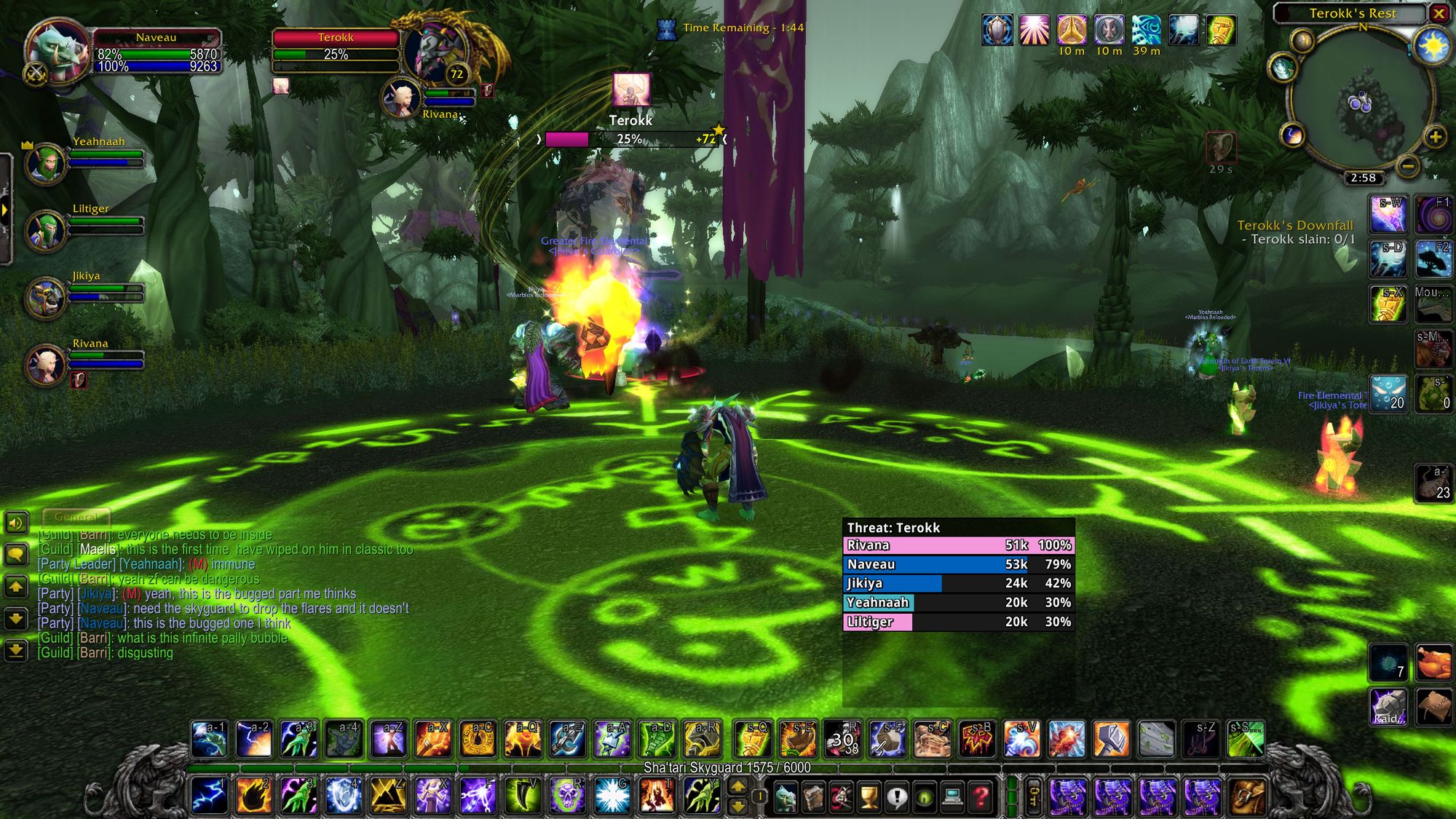
You don't have to do all that to unlock the daily, though. There are two dailies, but only one you can get from a questgiver in the camp. They send you on a bombing run with your flying mount to kill the giant bird eggs (not birdman, which is different) which are nested in the treetop villages.
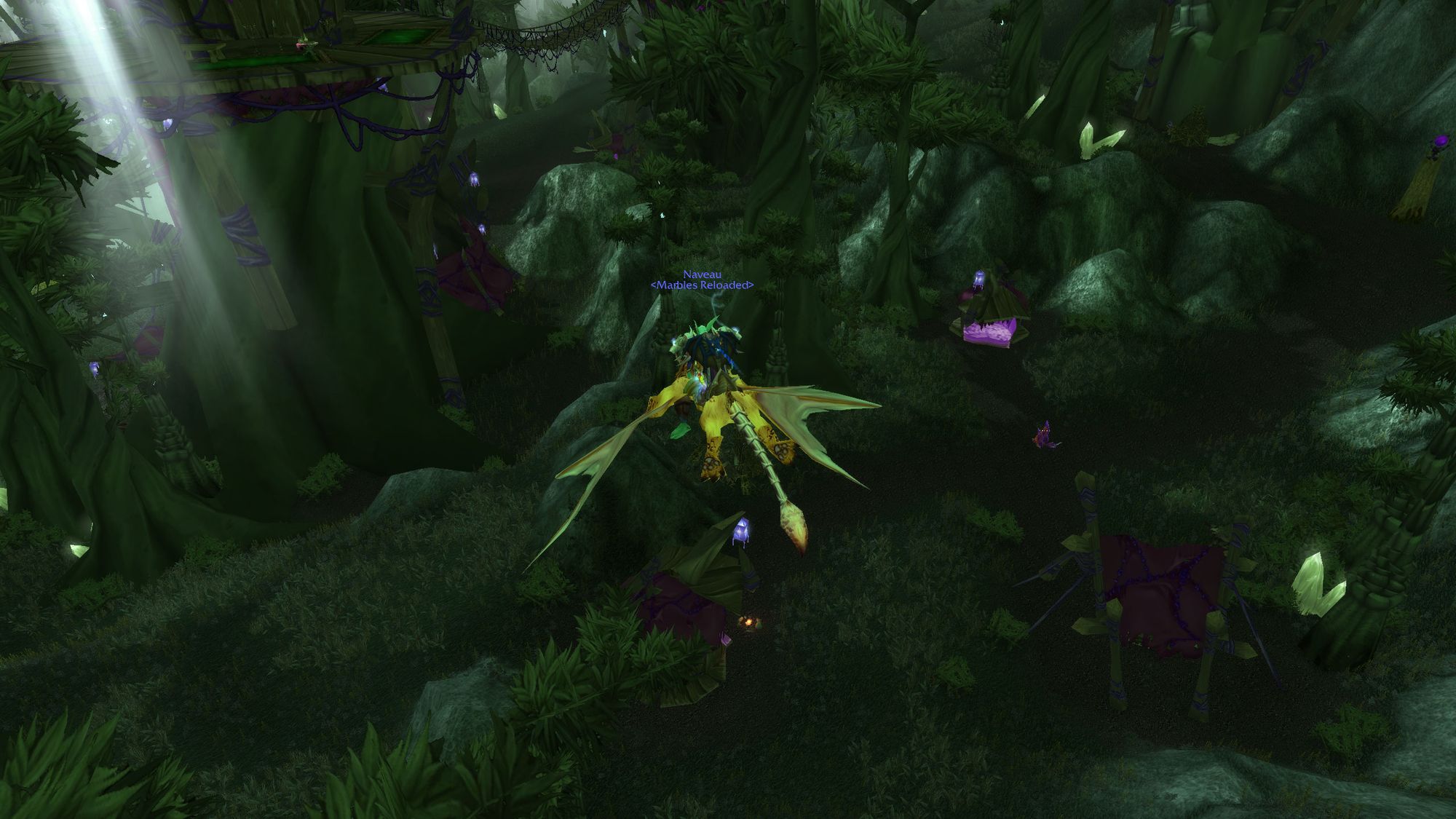
Again, I made a mouseover macro because clicking twice is hard.
The second quest is an escort. You find Skyguard prisoners in the tree villages inhabited by the birdmen. There are only three spawn points, so competition for this quest initially was so fierce that I didn't bother for more than a month. But you release him, walk him across the tree villages, then down the ramp, killing Arakkoa goons, then you and recieve your gold.
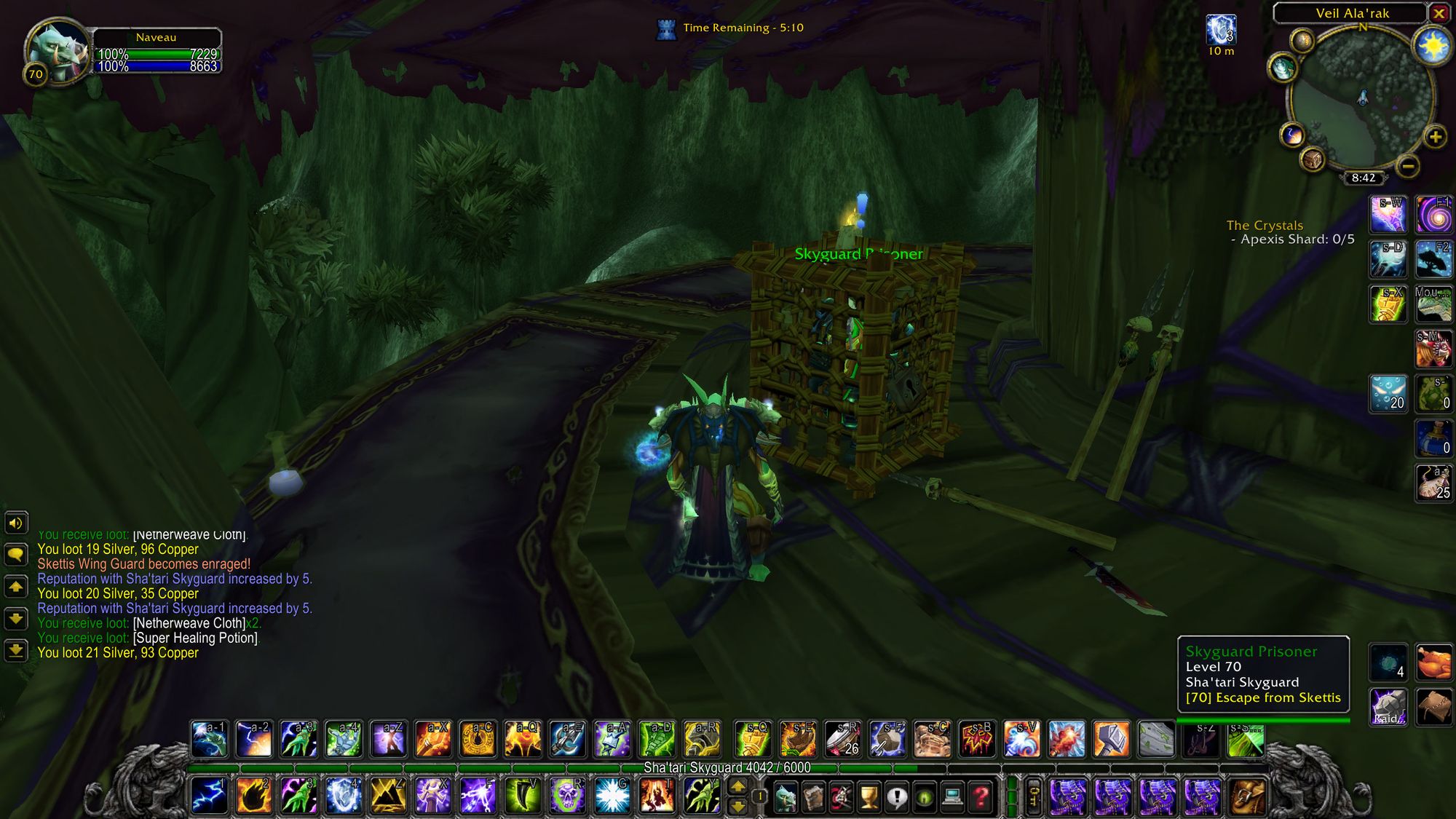
Phases one and two really had relatively low gold yields. The real game was still very much the auction house and those who were bad at economics had yet to gain access to the much higher, if grindier, gold yields of phase 3 and then much later, the supercharged gold yields of phase 5.
So to make ends meet, often it was best practice to take advantage of guildies who could make consumables like mana potions, flasks,two crafted neck pieces you used to "neck twist", food, and weapon oils.
Alchemy in particular, had a chance occasionally produce multiple potions and flasks from a single craft. Rather than pay huge sums of gold from the auction house for one, you could get lucky with your materials and end up with two, three, even five flasks. It also gave you a big dose of the good chemicals knowing you got to keep your gold for another day.
It wasn't until very late into Phase 4, when I had started to become exhausted with TBC, that I gave up my miserly ways and started to buy my consumables.
I am, of course, forgetting one last way you could "make" gold...
Moneymaker No. 3 - The GDKP
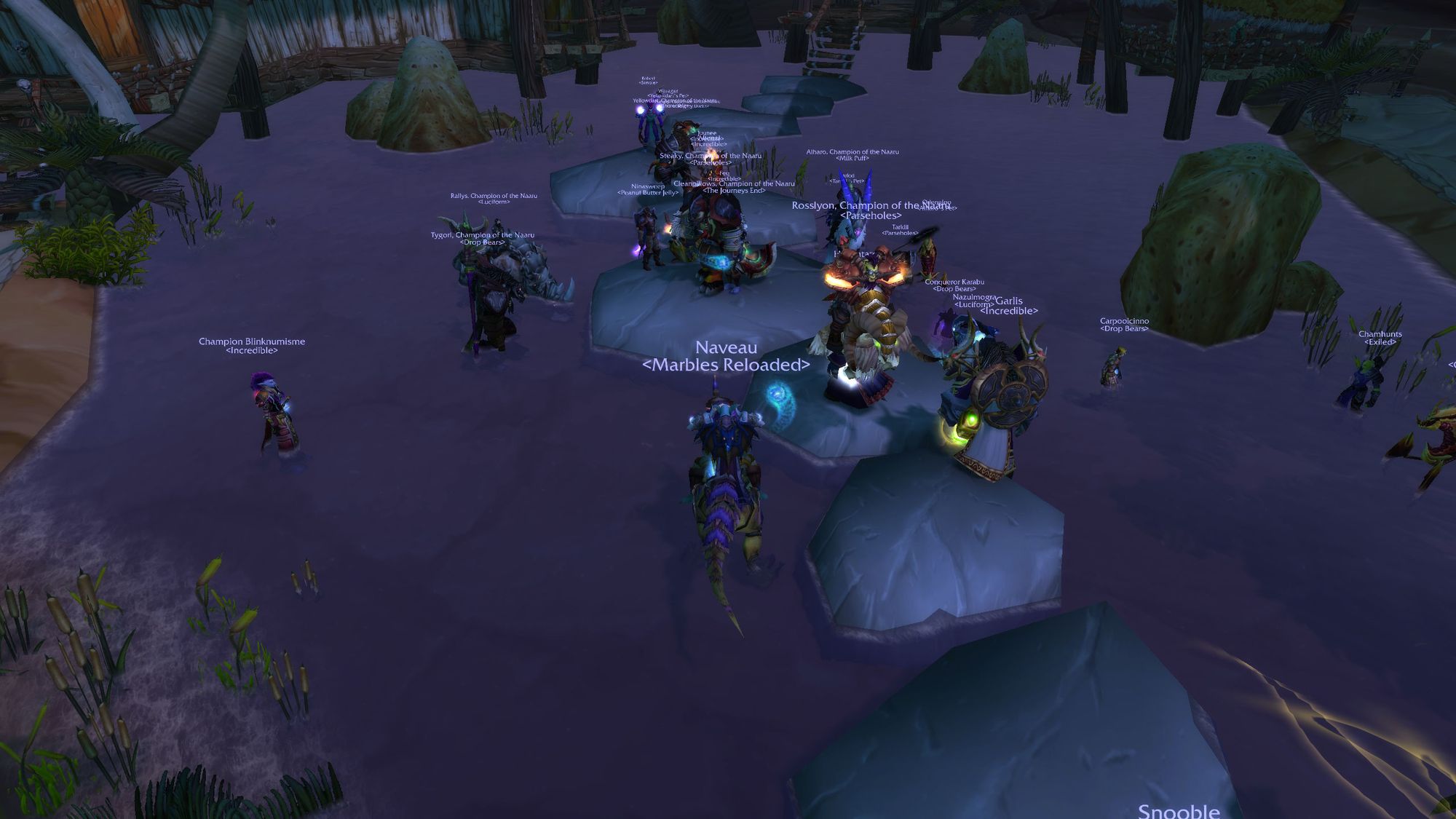
A GDKP (or, *the* GDKP, as there was only one on Horde Remulos in TBC) stands for "Gold Dragon Kill Points". Dragon Kill Points (or, DKP) are an ancient system used in original World of Warcraft as a way to distribute loot fairly, rather than having it all be decided by die rolls.
Remember that meme video where someone screeched about a 50 DKP minus? Now you know what that means. Sort of.
A GDKP means that you use gold to bid instead of points. So you are buying items from a raid, with gold.
But that's not all. At the end of the raid, the gold paid in is pooled, then redistributed amongst the players. The organiser takes a modest cut from the top, along with performance incentives for key positions, like resistance tanks, actual tanks and top performaing damage dealers and healers.
So it's not quite money on a loop unless the items you're buying are cheap. Which is not always the case. In my Gruul raid report I mentioned the infamous DST - the lowest that item ever sold for was 10,000 gold. But, of course, only one person can win that contest, and all 25 players were rewarded for one person's large purse strings.
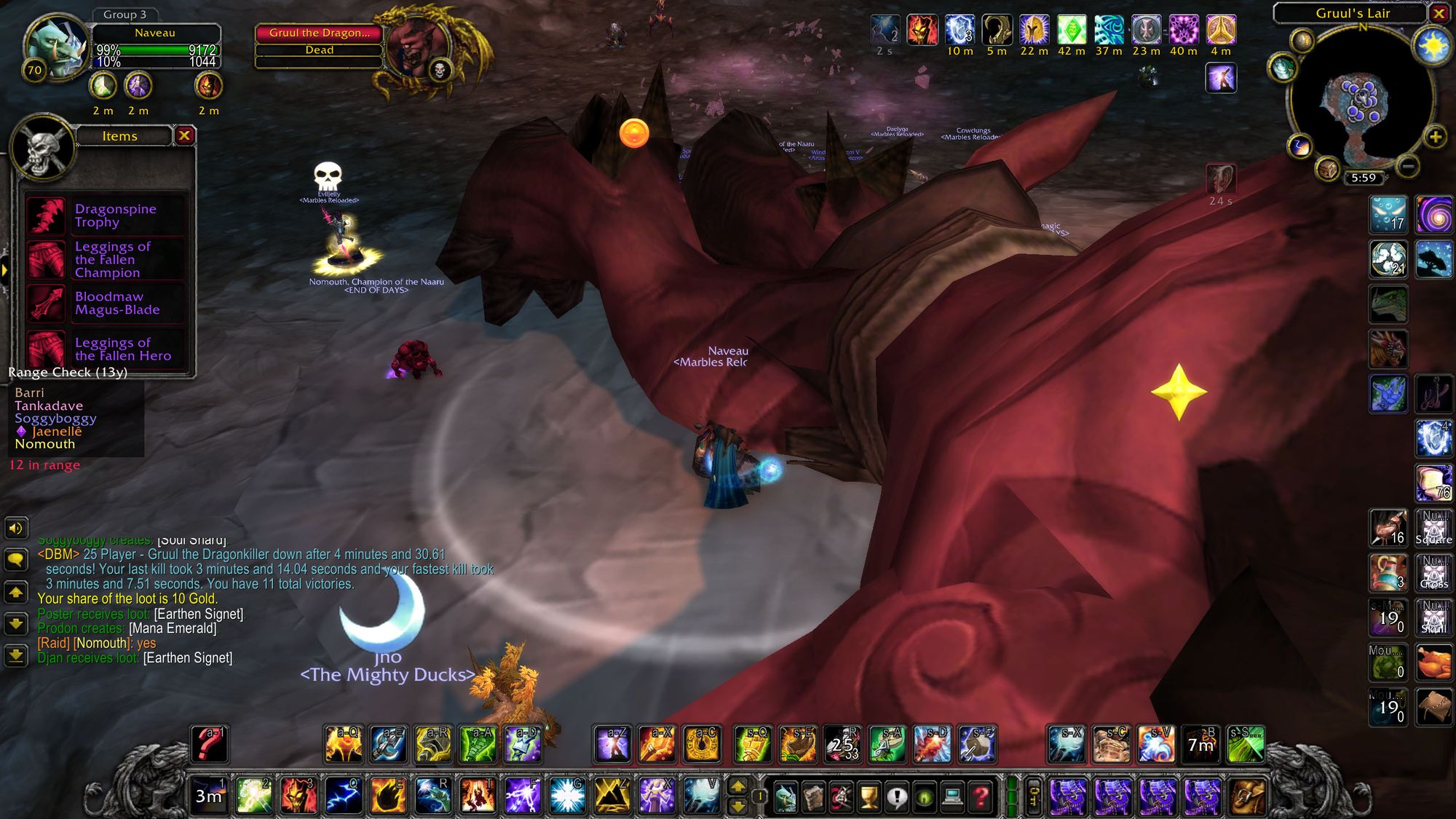
So whilst it's not a foolproof strategy, a canny player can give the impression they're there to buy items, bidding and competing, and then get pipped at the post by another person actually there to buy gear. The net result is a healthy amount of gold made for doing what you'd normally do in the game - raiding.
On more than one occasion, I did actually buy items from the GDKP to gear up. Early in phase 2, after moving to the Mighty Ducks, I bought up tier 4 shoulders when they peaked in price, and the best (at the time) spellcaster cloak. Both items lasted me for many moons, and I never once regretted my purchase.


But I also made out like a bandit, almost always out-earning what I had spent and getting some reasonable items for my alterate characters when I couldn't get a spot anywhere else. It also gave me a reason to do daily quests, knowing that the money I'd earn could be invested back into my character at a later point.
I'll probably do a full article on this at some point, but I have nothing but respect for the GDKP format. Losing a piece of gear, but knowing you'll be paid for it, takes much of the sting out of loot allocation. Whilst it's very capitalist, someone has either earned (or bought, let's be real) the gold required to purchase all the best items and their gold will soon become yours, provided you keep coming along and bidding.
Overall, phase one and two's non-raid mechanisms are a long way from TBCC's pinnacle, especially when considering that phase one and two should've been consolidated. However, there's an idea I stole from Cool Ghosts, which was in turn, stolen - the idea of "worthy work."
Yes, phase 3 and 5 brought with them more dailies, more gold, and made earning easier. But you felt less grateful for what you got. Amounts got higher, but there's something to be said of the effort required to earn when resources were more expensive and gold less plentiful. It's the struggle that makes you grumble about how hard you had to work, that also makes you appreciate the tenacity you had, and the creativity you employed to work around these limitations.
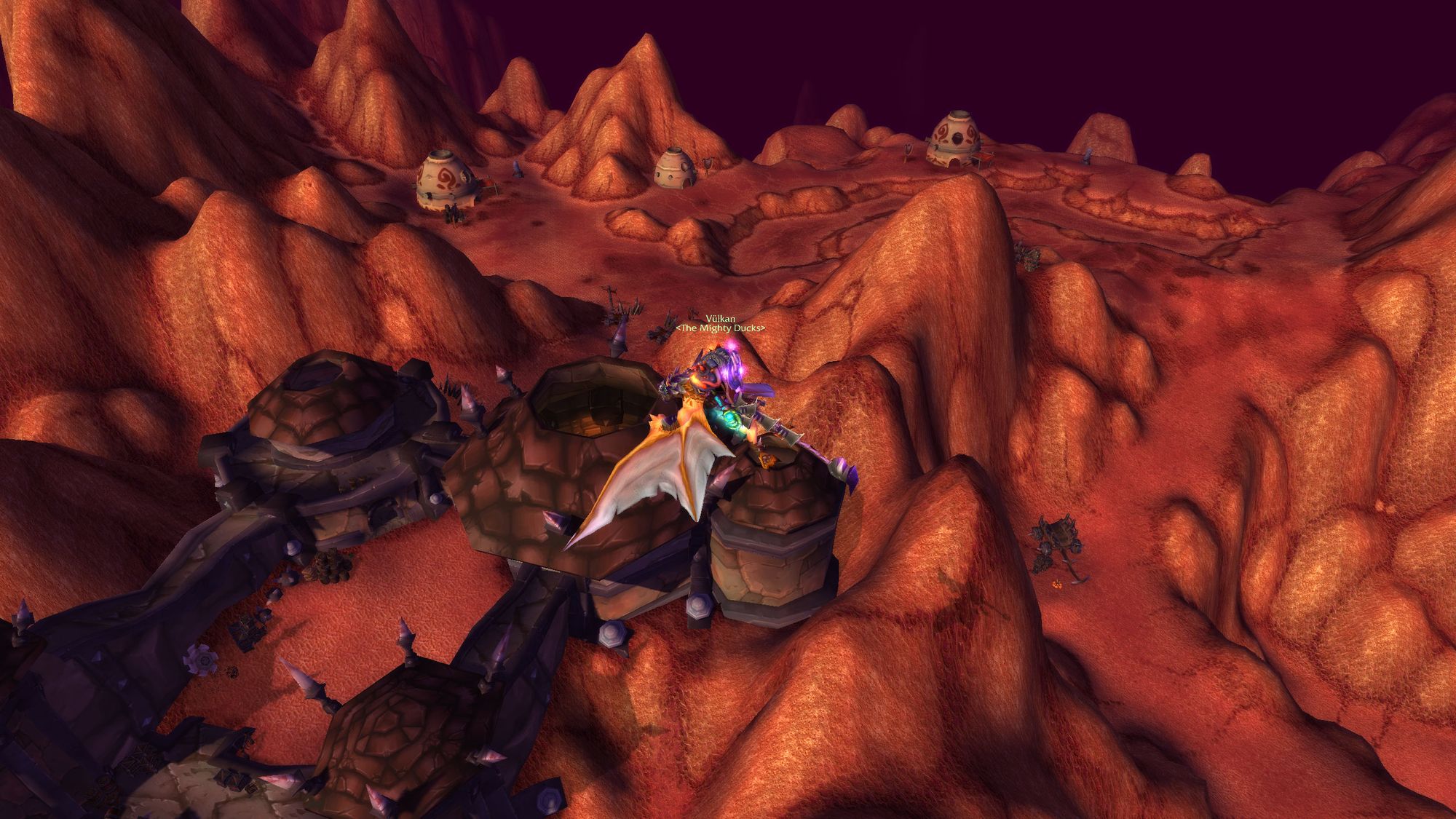
I hope to cover both future phases in some degree of detail. Regular readers will no doubt appreciate that I've been very slack, but very, very recently I have made a decision to prioritise my blog and produce the remaining WoW:TBC content. So stay tuned for that.
Catch you next time,
Vulkan
Did you like this article? Did you hate it? Go over and keep the discussion going on the official Vulkan's Corner facebook page! - whilst you're at it, leave a like!

